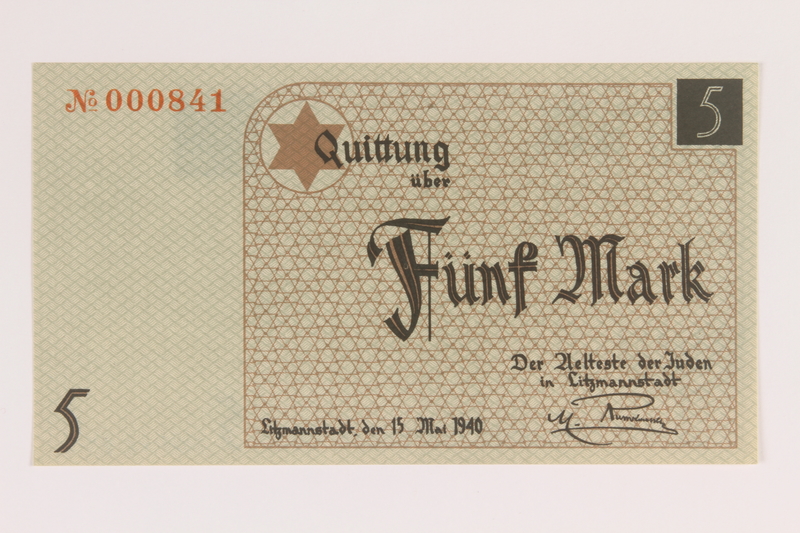Overview
- Brief Narrative
- 5 mark note receipt created in the Łódź ghetto and recovered from the ghetto by Malwina (Inka) Gerson and her parents, Dora and Gustav. When the Germans transferred Jews to the ghetto, they confiscated all currency in exchange for Quittungen [receipts] that could be spent only inside the ghetto. The scrip was designed by the Judenrat [Jewish Council] and includes traditional Jewish symbols. After the German occupation of Poland in 1939, 11 year old Inka and her family were forced into the Jewish ghetto in Łódź, which was renamed Litzmannstadt by the Germans. All ghetto inhabitants over the age of 10 had to work and Inka worked in a hat-making workshop. The Germans destroyed the ghetto in July 1944 and Inka's family was part of the work detail kept to clean up and salvage materials from the ghetto and to dig mass graves. The Allen family avoided the subsequent deportations to concentration camps and were still living in the ghetto when the city was liberated by the Russian Army in early 1945. The family left Poland for Bolivia in 1945.
- Date
-
issue:
1940 May 15
found: approximately 1944 July
- Geography
-
issue:
Litzmannstadt-Getto (Łódź, Poland);
Łódź (Poland)
found: Litzmannstadt-Getto (Łódź, Poland); Łódź (Poland)
- Credit Line
- United States Holocaust Memorial Museum Collection, Gift of Malwina "Inka" Gerson Allen
- Markings
- face, upper right corner, printed, black ink : 5
face lower left corner, printed black and orange ink : 5
face, rectangle upper left corner, printed, black ink : Quittung / über [Receipt for]
face, center, printed, black and orange ink : Fünf Mark [Five Marks]
face, bottom, printed, black ink : Der Aelteste der Juden / in Litzmannstadt / M. Rumkowski / Litzmannstadt, den 15 Mai 1940 [Receipt for five marks / The Elder of the Jews in Litzmannstadt M. Rumkowski / Litzmannstadt, 15 May 1940]
reverse, upper left corner, printed black ink : Quittung über / Fünf Mark [Reciept for five marks]
reverse, bottom, printed, black ink : WER DIESE QUITTUNG VERFÄLSCHT ODER NACHMACHT ODER GEFÄLSCHTE / QUITTUNGEN IN VERKEHR BRINGT / WIRD STRENGSTENS BESTRAFT [Anyone who falsifies or copies this receipt, or traffics in counterfeit receipts, will be strictly punished]
reverse, lower right, printed, black and orange ink : 5 - Contributor
-
Subject:
Malwina "Inka" Gerson Allen
- Biography
-
Malwina (Inka) Gerson was born on March 17,1929, in Łódź, Poland, to Gustav and Dora Stillerman Gerson. Gustav’s parents were from Latvia, but he was born in Warsaw, and raised in Łódź. He had three younger siblings, Leon, Gerda, and Wila. Dora’s parents were from Belarus; she was born in Łódź and had a brother, Samuel (Mula). Dora’s family moved to Moscow when World War I began in 1914; her father died about 1918 and the family returned to Poland in the 1920s. Dora and Gustav met on the train ride back to Łódź. Gustav had been in Moscow since 1914, where he attended business school. They married in Łódź on April 7, 1925. Gustav was a textile engineer and manufacturer of high quality cotton fabrics in Łódź. Dora helped him with the business. The family lived a cultured, middle class life, and spoke Polish, Russian, and German at home. There was a nanny and then a governess for Inka, who attended a private girl’s school.
The Germans invaded Poland on September 1, 1939, and Łódź was soon occupied. Dora's brother, Samuel, fled to Lvov (Lviv, Ukraine) with his family, and Gustav's brother, Leo, went to Warsaw with his wife, Marysia. The Germans soon put in place regulations to restrict and persecute Jews. They were not allowed to travel in certain parts of the city, attend public schools, and they had to wear yellow Star of David badges on their outer clothing. In November, the Gersons were evicted from their home and most of their possessions were taken by the Germans. In January 1940, Inka, her parents, and her maternal grandmother, Bertha Stillerman, who lived with them, were forced to move to the sealed ghetto. They lived in a single room, without running water and very little heat. After 1941, they no longer received any mail from relatives outside the ghetto. For the first year, Inka attended the ghetto school. There were classes in Hebrew and Judaism, but any subjects relating to Poland were forbidden. Soon the school was closed and twelve year old Inka had to work. Her first job was in the hat division where she made belts and artificial flowers; next, she worked in the knitting division making large, elaborate tablecloths and sweaters, and macramé bags. Her mother worked in the office of the rag sorting workshop and her father managed Central Purchasing, where ghetto inhabitants could sell their belongings for ghetto scrip. Living conditions grew steadily worse and disease and illness from lack of food were widespread. In 1942, Inka and her mother were ill with typhus and Inka’s grandmother died.
During the summer of 1944, the Germans decided to liquidate the ghetto and deport the inhabitants to Auschwitz. A small crew of approximately 900 residents was retained to sort the remaining belongings for shipment to Germany. Since Gustav was fluent in German, as well as a trained textile engineer, the Germans told him to stay. Inka and Dora were allowed to remain with him. People were divided into work groups and there were daily roll calls. At first, the women went through abandoned apartments, packing up reusable items, while the men dismantled workshops. Later, everyone worked packing up goods. The gates were locked at night. At some point, the inmates were ordered to dig mass graves at the Jewish cemetery, which they took as a sign that the Germans were planning to execute everyone. By this time, the Soviet Army was advancing quickly toward the city. One evening, word spread that the executions were planned for the next day. The camp overseers managed to keep the gates unlocked and told everyone to flee and hide. Inka and her parents found a small, dilapidated wooden house and hid there for a few days. They could hear fighting, as well as the German troops searching for hidden Jews. Then all became quiet. Gustav decided to go out and look, and the next thing Inka remembers is her friend, Janka Weinberg (now Raplewska), running up the stairs screaming: “Why are you still sitting here, the Russians are here and we are saved!" The ghetto was liberated on January 17, 1945.
Dora met two cousins who were serving with the Russian army and, through them, cabled Bolivia to tell Gustav’s sisters that they had survived. Prior to the war, his sister, Gerda, had married Dr. Robert Herzenberg, who had emigrated to Bolivia in 1929, and was head of the Hochschild Mines analytical chemistry laboratory. His other sister had joined them there before the war. The Gersons remained in Łódź for the next year and a half, making preparations to emigrate to Bolivia. When their belongings were taken by the Germans, Dora had given some jewelry to their Polish housekeeper, Klementyna, for safekeeping. She returned these items to them after the war. Gustav got a job in a textile factory. They learned that Gustav’s brother, Leo, and his wife had perished. Dora's brother, Mula, was killed in Budapest on the last day of the occupation, but his wife, Betty, and daughter, Janka, survived and emigrated to Israel.
Dora worked for Dr. Philip Friedman, who was investigating German anti-Jewish atrocities and also for TOZ, a health and welfare organization. Inka returned to school when it reopened in February. In June 1946, the family left for Sweden, and after a few months, sailed to Bolivia via England and Panama. Inka finished high school in Bolivia and attended a local technical college until her uncle arranged for her to go to MIT to continue her studies. Inka left Bolivia in September 1949. She met Steven Allen (originally Margulies), born in Vienna, whose family escaped Austria in 1940, at MIT where they obtained doctorates: Inka in chemistry, Steve in metallurgy. They married in 1951 and had two children. Inka became a college chemistry professor. Steve died on April 12, 2012, age 84.
Physical Details
- Language
- German
- Classification
-
Exchange Media
- Category
-
Money
- Object Type
-
Scrip (aat)
- Physical Description
- Offwhite rectangular paper scrip. The face has a watermark with a latticework pattern in green ink. The serial number in orange ink is in the upper left corner. The denomination 5 is in the lower left corner in bold font and in the upper right in a black square. There is a 1.75 inch left margin, then a rectangle with a curved upper left corner with a background of interlocked Jewish stars with a large Jewish star in a circle in the upper left corner in brown ink. Across the center is the textual denomination in black ink with brown highlights and German text. The back has a blank 1.75 inch margin, then a rectangle with a pattern of interlocked Stars of David in brown ink. There is German text in the upper left corner and a 7-branched candelabrum in the lower left corner. The denomination 5 in bold font, black and brown ink, is outside the border at the lower left corner; above this, near the upper right corner, is a Star of David outline in a black square.
- Dimensions
- overall: Height: 2.310 inches (5.867 cm) | Width: 5.310 inches (13.487 cm)
- Materials
- overall : paper, ink
- Inscription
- face, upper left corner, stamped, red ink : No 000841
Rights & Restrictions
- Conditions on Access
- No restrictions on access
- Conditions on Use
- No restrictions on use
Keywords & Subjects
Administrative Notes
- Legal Status
- Permanent Collection
- Provenance
- The scrip was donated to the United States Holocaust Memorial Museum in 2007 by Malwina "Inka" Gerson Allen.
- Record last modified:
- 2022-07-28 18:11:26
- This page:
- https://collections.ushmm.org/search/catalog/irn518878
Download & Licensing
In-Person Research
- By Appointment
- Request 21 Days in Advance of Visit
- Plan a Research Visit
- Request to See This Object
Contact Us
Also in Malwina (Inka) Gerson Allen collection
The collection consists of Łódź ghetto scrip, brooches, posters, documents, newspapers, and photographs relating to the experiences of Malwina (Inka) Gerson and her parents, Gustav and Dora, in the Jewish ghetto in Łódź, Poland, during and after the Holocaust.
Date: 1940-1945

Brooch with a cut-out design of the fence and Jewish quarters sign made in Łódź Ghetto
Object
Elaborate cutout metal brooch with Łódź Ghetto bridge that was made in the Ghetto and recovered there by Malwina (Inka) Gerson and her parents, Dora and Gustav. After the German occupation of Poland in 1939, Inka, 11, and her family were forced into the Jewish ghetto in Łódź. All ghetto inhabitants over the age of 10 had to work and Inka worked in a hat-making workshop. The Germans destroyed the ghetto in July 1944 and deported the remaining residents to concentration camps or killing centers. Inka's family was part of the work detail kept to clean up and salvage materials and to dig mass graves. The Allen family avoided the subsequent deportations to concentration camps and were still living in the ghetto when the city was liberated by the Soviet Army in early 1945. The family left Poland for Bolivia in 1945.
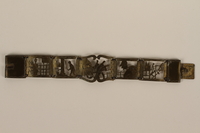
Brass bracelet with cutout designs of scenes of daily life made in Łódź Ghetto
Object
Brass bracelet made in Łódź Ghetto with seven links featuring 5 cut-out designs of cityscapes and daily life in the ghetto. It was recovered from the ghetto by Malwina (Inka) Gerson and her parents, Dora and Gustav. After the German occupation of Poland in 1939, 11 year old Inka and her family were forced into the Jewish ghetto in Łódź. All ghetto inhabitants over the age of 10 had to work and Inka worked in a hat-making workshop. The Germans destroyed the ghetto in July 1944 and Inka's family were part of the work detail kept to clean up and salvage materials from the ghetto and to dig mass graves. The Allen family avoided the subsequent deportations to concentration camps and were still living in the ghetto when the city was liberated by the Russian Army in early 1945. The family left Poland for Bolivia in 1945.
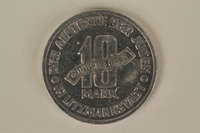
Łódź (Litzmannstadt) ghetto scrip, 10 mark coin
Object
10 mark coin minted in the Łódź ghetto and recovered from the ghetto by Malwina (Inka) Gerson and her parents, Dora and Gustav. When the Germans transferred Jews to the ghetto, they confiscated all currency in exchange for Quittungen [receipts] that could be spent only inside the ghetto. This specimen is from the second of two issues of coins. The scrip was designed by the Judenrat [Jewish Council] and includes traditional Jewish symbols. After the German occupation of Poland in 1939, 11 year old Inka and her family were forced into the Jewish ghetto in Łódź, which was renamed Litzmannstadt by the Germans. All ghetto inhabitants over the age of 10 had to work and Inka worked in a hat-making workshop. The Germans destroyed the ghetto in July 1944 and Inka's family was part of the work detail kept to clean up and salvage materials from the ghetto and to dig mass graves. The Allen family avoided the subsequent deportations to concentration camps and were still living in the ghetto when the city was liberated by the Russian Army in early 1945. The family left Poland for Bolivia in 1945.

Yellow cloth Star of David badge with a blank center
Object
Star of David worn in the Łódź ghetto and recovered from the ghetto by Malwina (Inka) Gerson and her parents, Dora and Gustav. After the German occupation of Poland in 1939, 11 year old Inka and her family were forced into the Jewish ghetto in Łódź, which was renamed Litzmannstadt by the Germans. All ghetto inhabitants over the age of 10 had to work and Inka worked in a hat-making workshop. The Germans destroyed the ghetto in July 1944 and Inka's family was part of the work detail kept to clean up and salvage materials from the ghetto and to dig mass graves. The Allen family avoided the subsequent deportations to concentration camps and were still living in the ghetto when the city was liberated by the Russian Army in early 1945. The family left Poland for Bolivia in 1945.
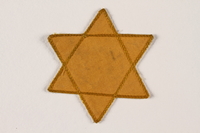
Yellow cloth Star of David badge with a blank center
Object
Star of David worn in the Łódź ghetto and recovered from the ghetto by Malwina (Inka) Gerson and her parents, Dora and Gustav. After the German occupation of Poland in 1939, 11 year old Inka and her family were forced into the Jewish ghetto in Łódź, which was renamed Litzmannstadt by the Germans. All ghetto inhabitants over the age of 10 had to work and Inka worked in a hat-making workshop. The Germans destroyed the ghetto in July 1944 and Inka's family was part of the work detail kept to clean up and salvage materials from the ghetto and to dig mass graves. The Allen family avoided the subsequent deportations to concentration camps and were still living in the ghetto when the city was liberated by the Russian Army in early 1945. The family left Poland for Bolivia in 1945. still living in the ghetto when the city was liberated by the Russian Army in early 1945. The family left Poland for Bolivia in 1945.
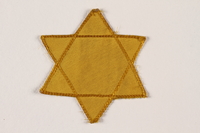
Yellow cloth Star of David badge with a blank center
Object
Star of David worn in the Łódź ghetto and recovered from the ghetto by Malwina (Inka) Gerson and her parents, Dora and Gustav. After the German occupation of Poland in 1939, 11 year old Inka and her family were forced into the Jewish ghetto in Łódź, which was renamed Litzmannstadt by the Germans. All ghetto inhabitants over the age of 10 had to work and Inka worked in a hat-making workshop. The Germans destroyed the ghetto in July 1944 and Inka's family was part of the work detail kept to clean up and salvage materials from the ghetto and to dig mass graves. The Allen family avoided the subsequent deportations to concentration camps and were still living in the ghetto when the city was liberated by the Russian Army in early 1945. The family left Poland for Bolivia in 1945. still living in the ghetto when the city was liberated by the Russian Army in early 1945. The family left Poland for Bolivia in 1945.

Yellow cloth Star of David badge with a blank center
Object
Star of David worn in the Łódź ghetto and recovered from the ghetto by Malwina (Inka) Gerson and her parents, Dora and Gustav. After the German occupation of Poland in 1939, 11 year old Inka and her family were forced into the Jewish ghetto in Łódź, which was renamed Litzmannstadt by the Germans. All ghetto inhabitants over the age of 10 had to work and Inka worked in a hat-making workshop. The Germans destroyed the ghetto in July 1944 and Inka's family was part of the work detail kept to clean up and salvage materials from the ghetto and to dig mass graves. The Allen family avoided the subsequent deportations to concentration camps and were still living in the ghetto when the city was liberated by the Russian Army in early 1945. The family left Poland for Bolivia in 1945. still living in the ghetto when the city was liberated by the Russian Army in early 1945. The family left Poland for Bolivia in 1945.
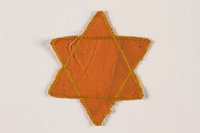
Yellow cloth Star of David badge with a blank center
Object
Star of David worn in the Łódź ghetto and recovered from the ghetto by Malwina (Inka) Gerson and her parents, Dora and Gustav. After the German occupation of Poland in 1939, 11 year old Inka and her family were forced into the Jewish ghetto in Łódź, which was renamed Litzmannstadt by the Germans. All ghetto inhabitants over the age of 10 had to work and Inka worked in a hat-making workshop. The Germans destroyed the ghetto in July 1944 and Inka's family was part of the work detail kept to clean up and salvage materials from the ghetto and to dig mass graves. The Allen family avoided the subsequent deportations to concentration camps and were still living in the ghetto when the city was liberated by the Russian Army in early 1945. The family left Poland for Bolivia in 1945.

Yellow cloth Star of David badge with a blank center
Object
Star of David worn in the Łódź ghetto and recovered from the ghetto by Malwina (Inka) Gerson and her parents, Dora and Gustav. After the German occupation of Poland in 1939, 11 year old Inka and her family were forced into the Jewish ghetto in Łódź, which was renamed Litzmannstadt by the Germans. All ghetto inhabitants over the age of 10 had to work and Inka worked in a hat-making workshop. The Germans destroyed the ghetto in July 1944 and Inka's family was part of the work detail kept to clean up and salvage materials from the ghetto and to dig mass graves. The Allen family avoided the subsequent deportations to concentration camps and were still living in the ghetto when the city was liberated by the Russian Army in early 1945. The family left Poland for Bolivia in 1945.

Yellow cloth Star of David badge with a blank center
Object
Star of David issued in Łódź Ghetto and recovered there by Malwina (Inka) Gerson and her parents, Dora and Gustav. After the German occupation of Poland in 1939, 11 year old Inka and her family were forced into the Jewish ghetto in Łódź, which was renamed Litzmannstadt by the Germans. All ghetto inhabitants over the age of 10 had to work and Inka worked in a hat-making workshop. The Germans destroyed the ghetto in July 1944 and Inka's family was part of the work detail kept to clean up and salvage materials from the ghetto and to dig mass graves. The Allen family avoided the subsequent deportations to concentration camps and were still living in the ghetto when the city was liberated by the Russian Army in early 1945. The family left Poland for Bolivia in 1945.

Yellow cloth Star of David badge with a blank center
Object
Star of David worn in the Łódź ghetto and recovered from the ghetto by Malwina (Inka) Gerson and her parents, Dora and Gustav. After the German occupation of Poland in 1939, 11 year old Inka and her family were forced into the Jewish ghetto in Łódź, which was renamed Litzmannstadt by the Germans. All ghetto inhabitants over the age of 10 had to work and Inka worked in a hat-making workshop. The Germans destroyed the ghetto in July 1944 and Inka's family was part of the work detail kept to clean up and salvage materials from the ghetto and to dig mass graves. The Allen family avoided the subsequent deportations to concentration camps and were still living in the ghetto when the city was liberated by the Russian Army in early 1945. The family left Poland for Bolivia in 1945.

Unused yellow cloth Star of David badge with Jude printed in the center
Object
Star of David found in Łódź Ghetto by Malwina (Inka) Gerson and her parents, Dora and Gustav. After the German occupation of Poland in 1939, Inka, 11, and her family were forced into the Jewish ghetto in Łódź, which was renamed Litzmannstadt by the Germans. All ghetto inhabitants over the age of 10 had to work and Inka worked in a hat-making workshop. The Germans destroyed the ghetto in July 1944 and Inka's family was part of the work detail kept to clean up and salvage materials from the ghetto and to dig mass graves. The Allen family avoided the subsequent deportations to concentration camps and were still living in the ghetto when the city was liberated by the Russian Army in early 1945. The family left Poland for Bolivia in 1945.

Yellow cloth Star of David badge with Jude printed in the center
Object
Star of David worn in the Łódź ghetto and recovered from the ghetto by Malwina (Inka) Gerson and her parents, Dora and Gustav. After the German occupation of Poland in 1939, 11 year old Inka and her family were forced into the Jewish ghetto in Łódź, which was renamed Litzmannstadt by the Germans. All ghetto inhabitants over the age of 10 had to work and Inka worked in a hat-making workshop. The Germans destroyed the ghetto in July 1944 and Inka's family was part of the work detail kept to clean up and salvage materials from the ghetto and to dig mass graves. The Allen family avoided the subsequent deportations to concentration camps and were still living in the ghetto when the city was liberated by the Russian Army in early 1945. The family left Poland for Bolivia in 1945.
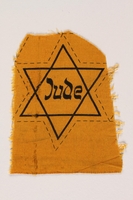
Unused yellow cloth Star of David badge with Jude printed in the center
Object
Star of David worn in the Łódź ghetto and recovered from the ghetto by Malwina (Inka) Gerson and her parents, Dora and Gustav. After the German occupation of Poland in 1939, 11 year old Inka and her family were forced into the Jewish ghetto in Łódź, which was renamed Litzmannstadt by the Germans. All ghetto inhabitants over the age of 10 had to work and Inka worked in a hat-making workshop. The Germans destroyed the ghetto in July 1944 and Inka's family was part of the work detail kept to clean up and salvage materials from the ghetto and to dig mass graves. The Allen family avoided the subsequent deportations to concentration camps and were still living in the ghetto when the city was liberated by the Russian Army in early 1945. The family left Poland for Bolivia in 1945.
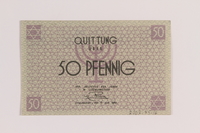
Łódź (Litzmannstadt) ghetto scrip, 50 pfennig note
Object
50 pfennig paper currency receipt created in the Łódź ghetto and recovered from the ghetto by Malwina (Inka) Gerson and her parents, Dora and Gustav. When the Germans transferred Jews to the ghetto, they confiscated all currency in exchange for Quittungen [receipts] that could be spent only inside the ghetto. The scrip was designed by the Judenrat [Jewish Council] and includes traditional Jewish symbols. After the German occupation of Poland in 1939, 11 year old Inka and her family were forced into the Jewish ghetto in Łódź, which was renamed Litzmannstadt by the Germans. All ghetto inhabitants over the age of 10 had to work and Inka worked in a hat-making workshop. The Germans destroyed the ghetto in July 1944 and Inka's family was part of the work detail kept to clean up and salvage materials from the ghetto and to dig mass graves. The Allen family avoided the subsequent deportations to concentration camps and were still living in the ghetto when the city was liberated by the Russian Army in early 1945. The family left Poland for Bolivia in 1945.
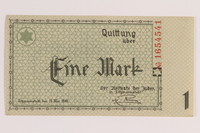
Łódź (Litzmannstadt) ghetto scrip, 1 mark note
Object
1 mark note receipt created in the Łódź ghetto and recovered from the ghetto by Malwina (Inka) Gerson and her parents, Dora and Gustav. When the Germans transferred Jews to the ghetto, they confiscated all currency in exchange for Quittungen [receipts] that could be spent only inside the ghetto. The scrip was designed by the Judenrat [Jewish Council] and includes traditional Jewish symbols. After the German occupation of Poland in 1939, 11 year old Inka and her family were forced into the Jewish ghetto in Łódź, which was renamed Litzmannstadt by the Germans. All ghetto inhabitants over the age of 10 had to work and Inka worked in a hat-making workshop. The Germans destroyed the ghetto in July 1944 and Inka's family was part of the work detail kept to clean up and salvage materials from the ghetto and to dig mass graves. The Allen family avoided the subsequent deportations to concentration camps and were still living in the ghetto when the city was liberated by the Russian Army in early 1945. The family left Poland for Bolivia in 1945.
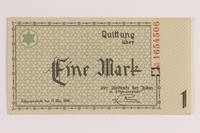
Łódź (Litzmannstadt) ghetto scrip, 1 mark note
Object
1 mark note receipt created in the Łódź ghetto and recovered from the ghetto by Malwina (Inka) Gerson and her parents, Dora and Gustav. When the Germans transferred Jews to the ghetto, they confiscated all currency in exchange for Quittungen [receipts] that could be spent only inside the ghetto. The scrip was designed by the Judenrat [Jewish Council] and includes traditional Jewish symbols. After the German occupation of Poland in 1939, 11 year old Inka and her family were forced into the Jewish ghetto in Łódź, which was renamed Litzmannstadt by the Germans. All ghetto inhabitants over the age of 10 had to work and Inka worked in a hat-making workshop. The Germans destroyed the ghetto in July 1944 and Inka's family was part of the work detail kept to clean up and salvage materials from the ghetto and to dig mass graves. The Allen family avoided the subsequent deportations to concentration camps and were still living in the ghetto when the city was liberated by the Russian Army in early 1945. The family left Poland for Bolivia in 1945.
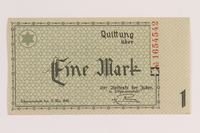
Łódź (Litzmannstadt) ghetto scrip, 1 mark note
Object
1 mark note receipt created in the Łódź ghetto and recovered from the ghetto by Malwina (Inka) Gerson and her parents, Dora and Gustav. When the Germans transferred Jews to the ghetto, they confiscated all currency in exchange for Quittungen [receipts] that could be spent only inside the ghetto. The scrip was designed by the Judenrat [Jewish Council] and includes traditional Jewish symbols. After the German occupation of Poland in 1939, 11 year old Inka and her family were forced into the Jewish ghetto in Łódź, which was renamed Litzmannstadt by the Germans. All ghetto inhabitants over the age of 10 had to work and Inka worked in a hat-making workshop. The Germans destroyed the ghetto in July 1944 and Inka's family was part of the work detail kept to clean up and salvage materials from the ghetto and to dig mass graves. The Allen family avoided the subsequent deportations to concentration camps and were still living in the ghetto when the city was liberated by the Russian Army in early 1945. The family left Poland for Bolivia in 1945.
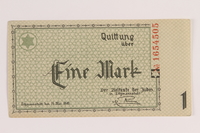
Łódź (Litzmannstadt) ghetto scrip, 1 mark note
Object
1 mark note receipt created in the Łódź ghetto and recovered from the ghetto by Malwina (Inka) Gerson and her parents, Dora and Gustav. When the Germans transferred Jews to the ghetto, they confiscated all currency in exchange for Quittungen [receipts] that could be spent only inside the ghetto. The scrip was designed by the Judenrat [Jewish Council] and includes traditional Jewish symbols. After the German occupation of Poland in 1939, 11 year old Inka and her family were forced into the Jewish ghetto in Łódź, which was renamed Litzmannstadt by the Germans. All ghetto inhabitants over the age of 10 had to work and Inka worked in a hat-making workshop. The Germans destroyed the ghetto in July 1944 and Inka's family was part of the work detail kept to clean up and salvage materials from the ghetto and to dig mass graves. The Allen family avoided the subsequent deportations to concentration camps and were still living in the ghetto when the city was liberated by the Russian Army in early 1945. The family left Poland for Bolivia in 1945.

Łódź (Litzmannstadt) ghetto scrip, 1 mark note
Object
1 mark note receipt created in the Łódź ghetto and recovered from the ghetto by Malwina (Inka) Gerson and her parents, Dora and Gustav. When the Germans transferred Jews to the ghetto, they confiscated all currency in exchange for Quittungen [receipts] that could be spent only inside the ghetto. The scrip was designed by the Judenrat [Jewish Council] and includes traditional Jewish symbols. After the German occupation of Poland in 1939, 11 year old Inka and her family were forced into the Jewish ghetto in Łódź, which was renamed Litzmannstadt by the Germans. All ghetto inhabitants over the age of 10 had to work and Inka worked in a hat-making workshop. The Germans destroyed the ghetto in July 1944 and Inka's family was part of the work detail kept to clean up and salvage materials from the ghetto and to dig mass graves. The Allen family avoided the subsequent deportations to concentration camps and were still living in the ghetto when the city was liberated by the Russian Army in early 1945. The family left Poland for Bolivia in 1945.

Łódź (Litzmannstadt) ghetto scrip, 1 mark note
Object
1 mark note receipt created in the Łódź ghetto and recovered from the ghetto by Malwina (Inka) Gerson and her parents, Dora and Gustav. When the Germans transferred Jews to the ghetto, they confiscated all currency in exchange for Quittungen [receipts] that could be spent only inside the ghetto. The scrip was designed by the Judenrat [Jewish Council] and includes traditional Jewish symbols. After the German occupation of Poland in 1939, 11 year old Inka and her family were forced into the Jewish ghetto in Łódź, which was renamed Litzmannstadt by the Germans. All ghetto inhabitants over the age of 10 had to work and Inka worked in a hat-making workshop. The Germans destroyed the ghetto in July 1944 and Inka's family was part of the work detail kept to clean up and salvage materials from the ghetto and to dig mass graves. The Allen family avoided the subsequent deportations to concentration camps and were still living in the ghetto when the city was liberated by the Russian Army in early 1945. The family left Poland for Bolivia in 1945.
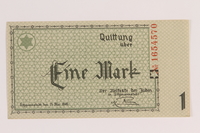
Łódź (Litzmannstadt) ghetto scrip, 1 mark note
Object
1 mark note receipt created in the Łódź ghetto and recovered from the ghetto by Malwina (Inka) Gerson and her parents, Dora and Gustav. When the Germans transferred Jews to the ghetto, they confiscated all currency in exchange for Quittungen [receipts] that could be spent only inside the ghetto. The scrip was designed by the Judenrat [Jewish Council] and includes traditional Jewish symbols. After the German occupation of Poland in 1939, 11 year old Inka and her family were forced into the Jewish ghetto in Łódź, which was renamed Litzmannstadt by the Germans. All ghetto inhabitants over the age of 10 had to work and Inka worked in a hat-making workshop. The Germans destroyed the ghetto in July 1944 and Inka's family was part of the work detail kept to clean up and salvage materials from the ghetto and to dig mass graves. The Allen family avoided the subsequent deportations to concentration camps and were still living in the ghetto when the city was liberated by the Russian Army in early 1945. The family left Poland for Bolivia in 1945.

Łódź (Litzmannstadt) ghetto scrip, 1 mark note
Object
1 mark note receipt created in the Łódź ghetto and recovered from the ghetto by Malwina (Inka) Gerson and her parents, Dora and Gustav. When the Germans transferred Jews to the ghetto, they confiscated all currency in exchange for Quittungen [receipts] that could be spent only inside the ghetto. The scrip was designed by the Judenrat [Jewish Council] and includes traditional Jewish symbols. After the German occupation of Poland in 1939, 11 year old Inka and her family were forced into the Jewish ghetto in Łódź, which was renamed Litzmannstadt by the Germans. All ghetto inhabitants over the age of 10 had to work and Inka worked in a hat-making workshop. The Germans destroyed the ghetto in July 1944 and Inka's family was part of the work detail kept to clean up and salvage materials from the ghetto and to dig mass graves. The Allen family avoided the subsequent deportations to concentration camps and were still living in the ghetto when the city was liberated by the Russian Army in early 1945. The family left Poland for Bolivia in 1945.

Łódź (Litzmannstadt) ghetto scrip, 1 mark note
Object
1 mark note receipt created in the Łódź ghetto and recovered from the ghetto by Malwina (Inka) Gerson and her parents, Dora and Gustav. When the Germans transferred Jews to the ghetto, they confiscated all currency in exchange for Quittungen [receipts] that could be spent only inside the ghetto. The scrip was designed by the Judenrat [Jewish Council] and includes traditional Jewish symbols. After the German occupation of Poland in 1939, 11 year old Inka and her family were forced into the Jewish ghetto in Łódź, which was renamed Litzmannstadt by the Germans. All ghetto inhabitants over the age of 10 had to work and Inka worked in a hat-making workshop. The Germans destroyed the ghetto in July 1944 and Inka's family was part of the work detail kept to clean up and salvage materials from the ghetto and to dig mass graves. The Allen family avoided the subsequent deportations to concentration camps and were still living in the ghetto when the city was liberated by the Soviet Army in early 1945. The family left Poland for Bolivia in 1945.
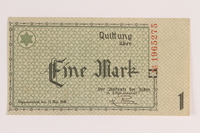
Łódź (Litzmannstadt) ghetto scrip, 1 mark note
Object
1 mark note receipt created in the Łódź ghetto and recovered from the ghetto by Malwina (Inka) Gerson and her parents, Dora and Gustav. When the Germans transferred Jews to the ghetto, they confiscated all currency in exchange for Quittungen [receipts] that could be spent only inside the ghetto. The scrip was designed by the Judenrat [Jewish Council] and includes traditional Jewish symbols. After the German occupation of Poland in 1939, 11 year old Inka and her family were forced into the Jewish ghetto in Łódź, which was renamed Litzmannstadt by the Germans. All ghetto inhabitants over the age of 10 had to work and Inka worked in a hat-making workshop. The Germans destroyed the ghetto in July 1944 and Inka's family was part of the work detail kept to clean up and salvage materials from the ghetto and to dig mass graves. The Allen family avoided the subsequent deportations to concentration camps and were still living in the ghetto when the city was liberated by the Russian Army in early 1945. The family left Poland for Bolivia in 1945.

Łódź (Litzmannstadt) ghetto scrip, 1 mark note
Object
1 mark note receipt created in the Łódź ghetto and recovered from the ghetto by Malwina (Inka) Gerson and her parents, Dora and Gustav. When the Germans transferred Jews to the ghetto, they confiscated all currency in exchange for Quittungen [receipts] that could be spent only inside the ghetto. The scrip was designed by the Judenrat [Jewish Council] and includes traditional Jewish symbols. After the German occupation of Poland in 1939, 11 year old Inka and her family were forced into the Jewish ghetto in Łódź, which was renamed Litzmannstadt by the Germans. All ghetto inhabitants over the age of 10 had to work and Inka worked in a hat-making workshop. The Germans destroyed the ghetto in July 1944 and Inka's family was part of the work detail kept to clean up and salvage materials from the ghetto and to dig mass graves. The Allen family avoided the subsequent deportations to concentration camps and were still living in the ghetto when the city was liberated by the Russian Army in early 1945. The family left Poland for Bolivia in 1945.

Łódź (Litzmannstadt) ghetto scrip, 1 mark note
Object
1 mark note receipt created in the Łódź ghetto and recovered from the ghetto by Malwina (Inka) Gerson and her parents, Dora and Gustav. When the Germans transferred Jews to the ghetto, they confiscated all currency in exchange for Quittungen [receipts] that could be spent only inside the ghetto. The scrip was designed by the Judenrat [Jewish Council] and includes traditional Jewish symbols. After the German occupation of Poland in 1939, 11 year old Inka and her family were forced into the Jewish ghetto in Łódź, which was renamed Litzmannstadt by the Germans. All ghetto inhabitants over the age of 10 had to work and Inka worked in a hat-making workshop. The Germans destroyed the ghetto in July 1944 and Inka's family was part of the work detail kept to clean up and salvage materials from the ghetto and to dig mass graves. The Allen family avoided the subsequent deportations to concentration camps and were still living in the ghetto when the city was liberated by the Russian Army in early 1945. The family left Poland for Bolivia in 1945.

Łódź (Litzmannstadt) ghetto scrip, 1 mark note
Object
1 mark note receipt created in the Łódź ghetto and recovered from the ghetto by Malwina (Inka) Gerson and her parents, Dora and Gustav. When the Germans transferred Jews to the ghetto, they confiscated all currency in exchange for Quittungen [receipts] that could be spent only inside the ghetto. The scrip was designed by the Judenrat [Jewish Council] and includes traditional Jewish symbols. After the German occupation of Poland in 1939, 11 year old Inka and her family were forced into the Jewish ghetto in Łódź, which was renamed Litzmannstadt by the Germans. All ghetto inhabitants over the age of 10 had to work and Inka worked in a hat-making workshop. The Germans destroyed the ghetto in July 1944 and Inka's family was part of the work detail kept to clean up and salvage materials from the ghetto and to dig mass graves. The Allen family avoided the subsequent deportations to concentration camps and were still living in the ghetto when the city was liberated by the Russian Army in early 1945. The family left Poland for Bolivia in 1945.
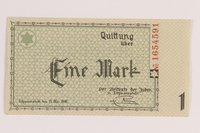
Łódź (Litzmannstadt) ghetto scrip, 1 mark note
Object
1 mark note receipt created in the Łódź ghetto and recovered from the ghetto by Malwina (Inka) Gerson and her parents, Dora and Gustav. When the Germans transferred Jews to the ghetto, they confiscated all currency in exchange for Quittungen [receipts] that could be spent only inside the ghetto. The scrip was designed by the Judenrat [Jewish Council] and includes traditional Jewish symbols. After the German occupation of Poland in 1939, 11 year old Inka and her family were forced into the Jewish ghetto in Łódź, which was renamed Litzmannstadt by the Germans. All ghetto inhabitants over the age of 10 had to work and Inka worked in a hat-making workshop. The Germans destroyed the ghetto in July 1944 and Inka's family was part of the work detail kept to clean up and salvage materials from the ghetto and to dig mass graves. The Allen family avoided the subsequent deportations to concentration camps and were still living in the ghetto when the city was liberated by the Russian Army in early 1945. The family left Poland for Bolivia in 1945.
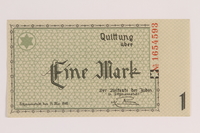
Łódź (Litzmannstadt) ghetto scrip, 1 mark note
Object
1 mark note receipt created in the Łódź ghetto and recovered from the ghetto by Malwina (Inka) Gerson and her parents, Dora and Gustav. When the Germans transferred Jews to the ghetto, they confiscated all currency in exchange for Quittungen [receipts] that could be spent only inside the ghetto. The scrip was designed by the Judenrat [Jewish Council] and includes traditional Jewish symbols. After the German occupation of Poland in 1939, 11 year old Inka and her family were forced into the Jewish ghetto in Łódź, which was renamed Litzmannstadt by the Germans. All ghetto inhabitants over the age of 10 had to work and Inka worked in a hat-making workshop. The Germans destroyed the ghetto in July 1944 and Inka's family was part of the work detail kept to clean up and salvage materials from the ghetto and to dig mass graves. The Allen family avoided the subsequent deportations to concentration camps and were still living in the ghetto when the city was liberated by the Russian Army in early 1945. The family left Poland for Bolivia in 1945.
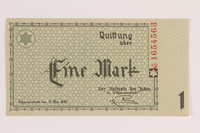
Łódź (Litzmannstadt) ghetto scrip, 1 mark note
Object
1 mark note receipt created in the Łódź ghetto and recovered from the ghetto by Malwina (Inka) Gerson and her parents, Dora and Gustav. When the Germans transferred Jews to the ghetto, they confiscated all currency in exchange for Quittungen [receipts] that could be spent only inside the ghetto. The scrip was designed by the Judenrat [Jewish Council] and includes traditional Jewish symbols. After the German occupation of Poland in 1939, 11 year old Inka and her family were forced into the Jewish ghetto in Łódź, which was renamed Litzmannstadt by the Germans. All ghetto inhabitants over the age of 10 had to work and Inka worked in a hat-making workshop. The Germans destroyed the ghetto in July 1944 and Inka's family was part of the work detail kept to clean up and salvage materials from the ghetto and to dig mass graves. The Allen family avoided the subsequent deportations to concentration camps and were still living in the ghetto when the city was liberated by the Russian Army in early 1945. The family left Poland for Bolivia in 1945.

Łódź (Litzmannstadt) ghetto scrip, 1 mark note
Object
1 mark note receipt created in the Łódź ghetto and recovered from the ghetto by Malwina (Inka) Gerson and her parents, Dora and Gustav. When the Germans transferred Jews to the ghetto, they confiscated all currency in exchange for Quittungen [receipts] that could be spent only inside the ghetto. The scrip was designed by the Judenrat [Jewish Council] and includes traditional Jewish symbols. After the German occupation of Poland in 1939, 11 year old Inka and her family were forced into the Jewish ghetto in Łódź, which was renamed Litzmannstadt by the Germans. All ghetto inhabitants over the age of 10 had to work and Inka worked in a hat-making workshop. The Germans destroyed the ghetto in July 1944 and Inka's family was part of the work detail kept to clean up and salvage materials from the ghetto and to dig mass graves. The Allen family avoided the subsequent deportations to concentration camps and were still living in the ghetto when the city was liberated by the Russian Army in early 1945. The family left Poland for Bolivia in 1945.
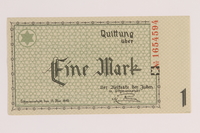
Łódź (Litzmannstadt) ghetto scrip, 1 mark note
Object
1 mark note receipt created in the Łódź ghetto and recovered from the ghetto by Malwina (Inka) Gerson and her parents, Dora and Gustav. When the Germans transferred Jews to the ghetto, they confiscated all currency in exchange for Quittungen [receipts] that could be spent only inside the ghetto. The scrip was designed by the Judenrat [Jewish Council] and includes traditional Jewish symbols. After the German occupation of Poland in 1939, 11 year old Inka and her family were forced into the Jewish ghetto in Łódź, which was renamed Litzmannstadt by the Germans. All ghetto inhabitants over the age of 10 had to work and Inka worked in a hat-making workshop. The Germans destroyed the ghetto in July 1944 and Inka's family was part of the work detail kept to clean up and salvage materials from the ghetto and to dig mass graves. The Allen family avoided the subsequent deportations to concentration camps and were still living in the ghetto when the city was liberated by the Russian Army in early 1945. The family left Poland for Bolivia in 1945.
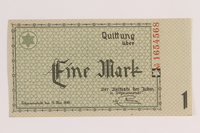
Łódź (Litzmannstadt) ghetto scrip, 1 mark note
Object
1 mark note receipt created in the Łódź ghetto and recovered from the ghetto by Malwina (Inka) Gerson and her parents, Dora and Gustav. When the Germans transferred Jews to the ghetto, they confiscated all currency in exchange for Quittungen [receipts] that could be spent only inside the ghetto. The scrip was designed by the Judenrat [Jewish Council] and includes traditional Jewish symbols. After the German occupation of Poland in 1939, 11 year old Inka and her family were forced into the Jewish ghetto in Łódź, which was renamed Litzmannstadt by the Germans. All ghetto inhabitants over the age of 10 had to work and Inka worked in a hat-making workshop. The Germans destroyed the ghetto in July 1944 and Inka's family was part of the work detail kept to clean up and salvage materials from the ghetto and to dig mass graves. The Allen family avoided the subsequent deportations to concentration camps and were still living in the ghetto when the city was liberated by the Russian Army in early 1945. The family left Poland for Bolivia in 1945.

Łódź (Litzmannstadt) ghetto scrip, 1 mark note
Object
1 mark note receipt created in the Łódź ghetto and recovered from the ghetto by Malwina (Inka) Gerson and her parents, Dora and Gustav. When the Germans transferred Jews to the ghetto, they confiscated all currency in exchange for Quittungen [receipts] that could be spent only inside the ghetto. The scrip was designed by the Judenrat [Jewish Council] and includes traditional Jewish symbols. After the German occupation of Poland in 1939, 11 year old Inka and her family were forced into the Jewish ghetto in Łódź, which was renamed Litzmannstadt by the Germans. All ghetto inhabitants over the age of 10 had to work and Inka worked in a hat-making workshop. The Germans destroyed the ghetto in July 1944 and Inka's family was part of the work detail kept to clean up and salvage materials from the ghetto and to dig mass graves. The Allen family avoided the subsequent deportations to concentration camps and were still living in the ghetto when the city was liberated by the Russian Army in early 1945. The family left Poland for Bolivia in 1945.

Łódź (Litzmannstadt) ghetto scrip, 1 mark note
Object
1 mark note receipt created in the Łódź ghetto and recovered from the ghetto by Malwina (Inka) Gerson and her parents, Dora and Gustav. When the Germans transferred Jews to the ghetto, they confiscated all currency in exchange for Quittungen [receipts] that could be spent only inside the ghetto. The scrip was designed by the Judenrat [Jewish Council] and includes traditional Jewish symbols. After the German occupation of Poland in 1939, 11 year old Inka and her family were forced into the Jewish ghetto in Łódź, which was renamed Litzmannstadt by the Germans. All ghetto inhabitants over the age of 10 had to work and Inka worked in a hat-making workshop. The Germans destroyed the ghetto in July 1944 and Inka's family was part of the work detail kept to clean up and salvage materials from the ghetto and to dig mass graves. The Allen family avoided the subsequent deportations to concentration camps and were still living in the ghetto when the city was liberated by the Russian Army in early 1945. The family left Poland for Bolivia in 1945.

Łódź (Litzmannstadt) ghetto scrip, 1 mark note
Object
1 mark note receipt created in the Łódź ghetto and recovered from the ghetto by Malwina (Inka) Gerson and her parents, Dora and Gustav. When the Germans transferred Jews to the ghetto, they confiscated all currency in exchange for Quittungen [receipts] that could be spent only inside the ghetto. The scrip was designed by the Judenrat [Jewish Council] and includes traditional Jewish symbols. After the German occupation of Poland in 1939, 11 year old Inka and her family were forced into the Jewish ghetto in Łódź, which was renamed Litzmannstadt by the Germans. All ghetto inhabitants over the age of 10 had to work and Inka worked in a hat-making workshop. The Germans destroyed the ghetto in July 1944 and Inka's family was part of the work detail kept to clean up and salvage materials from the ghetto and to dig mass graves. The Allen family avoided the subsequent deportations to concentration camps and were still living in the ghetto when the city was liberated by the Russian Army in early 1945. The family left Poland for Bolivia in 1945.
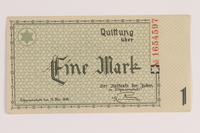
Łódź (Litzmannstadt) ghetto scrip, 1 mark note
Object
1 mark note receipt created in the Łódź ghetto and recovered from the ghetto by Malwina (Inka) Gerson and her parents, Dora and Gustav. When the Germans transferred Jews to the ghetto, they confiscated all currency in exchange for Quittungen [receipts] that could be spent only inside the ghetto. The scrip was designed by the Judenrat [Jewish Council] and includes traditional Jewish symbols. After the German occupation of Poland in 1939, 11 year old Inka and her family were forced into the Jewish ghetto in Łódź, which was renamed Litzmannstadt by the Germans. All ghetto inhabitants over the age of 10 had to work and Inka worked in a hat-making workshop. The Germans destroyed the ghetto in July 1944 and Inka's family was part of the work detail kept to clean up and salvage materials from the ghetto and to dig mass graves. The Allen family avoided the subsequent deportations to concentration camps and were still living in the ghetto when the city was liberated by the Russian Army in early 1945. The family left Poland for Bolivia in 1945.
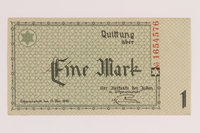
Łódź (Litzmannstadt) ghetto scrip, 1 mark note
Object
1 mark note receipt created in the Łódź ghetto and recovered from the ghetto by Malwina (Inka) Gerson and her parents, Dora and Gustav. When the Germans transferred Jews to the ghetto, they confiscated all currency in exchange for Quittungen [receipts] that could be spent only inside the ghetto. The scrip was designed by the Judenrat [Jewish Council] and includes traditional Jewish symbols. After the German occupation of Poland in 1939, 11 year old Inka and her family were forced into the Jewish ghetto in Łódź, which was renamed Litzmannstadt by the Germans. All ghetto inhabitants over the age of 10 had to work and Inka worked in a hat-making workshop. The Germans destroyed the ghetto in July 1944 and Inka's family was part of the work detail kept to clean up and salvage materials from the ghetto and to dig mass graves. The Allen family avoided the subsequent deportations to concentration camps and were still living in the ghetto when the city was liberated by the Russian Army in early 1945. The family left Poland for Bolivia in 1945.

Łódź (Litzmannstadt) ghetto scrip, 1 mark note
Object
1 mark note receipt created in the Łódź ghetto and recovered from the ghetto by Malwina (Inka) Gerson and her parents, Dora and Gustav. When the Germans transferred Jews to the ghetto, they confiscated all currency in exchange for Quittungen [receipts] that could be spent only inside the ghetto. The scrip was designed by the Judenrat [Jewish Council] and includes traditional Jewish symbols. After the German occupation of Poland in 1939, 11 year old Inka and her family were forced into the Jewish ghetto in Łódź, which was renamed Litzmannstadt by the Germans. All ghetto inhabitants over the age of 10 had to work and Inka worked in a hat-making workshop. The Germans destroyed the ghetto in July 1944 and Inka's family was part of the work detail kept to clean up and salvage materials from the ghetto and to dig mass graves. The Allen family avoided the subsequent deportations to concentration camps and were still living in the ghetto when the city was liberated by the Russian Army in early 1945. The family left Poland for Bolivia in 1945.

Łódź (Litzmannstadt) ghetto scrip, 1 mark note
Object
1 mark note receipt created in the Łódź ghetto and recovered from the ghetto by Malwina (Inka) Gerson and her parents, Dora and Gustav. When the Germans transferred Jews to the ghetto, they confiscated all currency in exchange for Quittungen [receipts] that could be spent only inside the ghetto. The scrip was designed by the Judenrat [Jewish Council] and includes traditional Jewish symbols. After the German occupation of Poland in 1939, 11 year old Inka and her family were forced into the Jewish ghetto in Łódź, which was renamed Litzmannstadt by the Germans. All ghetto inhabitants over the age of 10 had to work and Inka worked in a hat-making workshop. The Germans destroyed the ghetto in July 1944 and Inka's family was part of the work detail kept to clean up and salvage materials from the ghetto and to dig mass graves. The Allen family avoided the subsequent deportations to concentration camps and were still living in the ghetto when the city was liberated by the Russian Army in early 1945. The family left Poland for Bolivia in 1945.
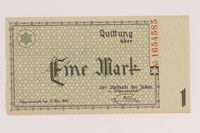
Łódź (Litzmannstadt) ghetto scrip, 1 mark note
Object
1 mark note receipt created in the Łódź ghetto and recovered from the ghetto by Malwina (Inka) Gerson and her parents, Dora and Gustav. When the Germans transferred Jews to the ghetto, they confiscated all currency in exchange for Quittungen [receipts] that could be spent only inside the ghetto. The scrip was designed by the Judenrat [Jewish Council] and includes traditional Jewish symbols. After the German occupation of Poland in 1939, 11 year old Inka and her family were forced into the Jewish ghetto in Łódź, which was renamed Litzmannstadt by the Germans. All ghetto inhabitants over the age of 10 had to work and Inka worked in a hat-making workshop. The Germans destroyed the ghetto in July 1944 and Inka's family was part of the work detail kept to clean up and salvage materials from the ghetto and to dig mass graves. The Allen family avoided the subsequent deportations to concentration camps and were still living in the ghetto when the city was liberated by the Russian Army in early 1945. The family left Poland for Bolivia in 1945.

Łódź (Litzmannstadt) ghetto scrip, 1 mark note
Object
1 mark note receipt created in the Łódź ghetto and recovered from the ghetto by Malwina (Inka) Gerson and her parents, Dora and Gustav. When the Germans transferred Jews to the ghetto, they confiscated all currency in exchange for Quittungen [receipts] that could be spent only inside the ghetto. The scrip was designed by the Judenrat [Jewish Council] and includes traditional Jewish symbols. After the German occupation of Poland in 1939, 11 year old Inka and her family were forced into the Jewish ghetto in Łódź, which was renamed Litzmannstadt by the Germans. All ghetto inhabitants over the age of 10 had to work and Inka worked in a hat-making workshop. The Germans destroyed the ghetto in July 1944 and Inka's family was part of the work detail kept to clean up and salvage materials from the ghetto and to dig mass graves. The Allen family avoided the subsequent deportations to concentration camps and were still living in the ghetto when the city was liberated by the Russian Army in early 1945. The family left Poland for Bolivia in 1945.
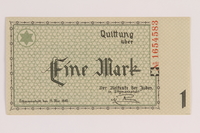
Łódź (Litzmannstadt) ghetto scrip, 1 mark note
Object
1 mark note receipt created in the Łódź ghetto and recovered from the ghetto by Malwina (Inka) Gerson and her parents, Dora and Gustav. When the Germans transferred Jews to the ghetto, they confiscated all currency in exchange for Quittungen [receipts] that could be spent only inside the ghetto. The scrip was designed by the Judenrat [Jewish Council] and includes traditional Jewish symbols. After the German occupation of Poland in 1939, 11 year old Inka and her family were forced into the Jewish ghetto in Łódź, which was renamed Litzmannstadt by the Germans. All ghetto inhabitants over the age of 10 had to work and Inka worked in a hat-making workshop. The Germans destroyed the ghetto in July 1944 and Inka's family was part of the work detail kept to clean up and salvage materials from the ghetto and to dig mass graves. The Allen family avoided the subsequent deportations to concentration camps and were still living in the ghetto when the city was liberated by the Russian Army in early 1945. The family left Poland for Bolivia in 1945.

Łódź (Litzmannstadt) ghetto scrip, 1 mark note
Object
1 mark note receipt created in the Łódź ghetto and recovered from the ghetto by Malwina (Inka) Gerson and her parents, Dora and Gustav. When the Germans transferred Jews to the ghetto, they confiscated all currency in exchange for Quittungen [receipts] that could be spent only inside the ghetto. The scrip was designed by the Judenrat [Jewish Council] and includes traditional Jewish symbols. After the German occupation of Poland in 1939, 11 year old Inka and her family were forced into the Jewish ghetto in Łódź, which was renamed Litzmannstadt by the Germans. All ghetto inhabitants over the age of 10 had to work and Inka worked in a hat-making workshop. The Germans destroyed the ghetto in July 1944 and Inka's family was part of the work detail kept to clean up and salvage materials from the ghetto and to dig mass graves. The Allen family avoided the subsequent deportations to concentration camps and were still living in the ghetto when the city was liberated by the Russian Army in early 1945. The family left Poland for Bolivia in 1945.
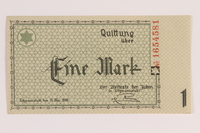
Łódź (Litzmannstadt) ghetto scrip, 1 mark note
Object
1 mark note receipt created in the Łódź ghetto and recovered from the ghetto by Malwina (Inka) Gerson and her parents, Dora and Gustav. When the Germans transferred Jews to the ghetto, they confiscated all currency in exchange for Quittungen [receipts] that could be spent only inside the ghetto. The scrip was designed by the Judenrat [Jewish Council] and includes traditional Jewish symbols. After the German occupation of Poland in 1939, 11 year old Inka and her family were forced into the Jewish ghetto in Łódź, which was renamed Litzmannstadt by the Germans. All ghetto inhabitants over the age of 10 had to work and Inka worked in a hat-making workshop. The Germans destroyed the ghetto in July 1944 and Inka's family was part of the work detail kept to clean up and salvage materials from the ghetto and to dig mass graves. The Allen family avoided the subsequent deportations to concentration camps and were still living in the ghetto when the city was liberated by the Russian Army in early 1945. The family left Poland for Bolivia in 1945.
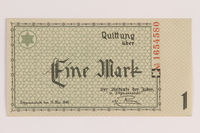
Łódź (Litzmannstadt) ghetto scrip, 1 mark note
Object
1 mark note receipt created in the Łódź ghetto and recovered from the ghetto by Malwina (Inka) Gerson and her parents, Dora and Gustav. When the Germans transferred Jews to the ghetto, they confiscated all currency in exchange for Quittungen [receipts] that could be spent only inside the ghetto. The scrip was designed by the Judenrat [Jewish Council] and includes traditional Jewish symbols. After the German occupation of Poland in 1939, 11 year old Inka and her family were forced into the Jewish ghetto in Łódź, which was renamed Litzmannstadt by the Germans. All ghetto inhabitants over the age of 10 had to work and Inka worked in a hat-making workshop. The Germans destroyed the ghetto in July 1944 and Inka's family was part of the work detail kept to clean up and salvage materials from the ghetto and to dig mass graves. The Allen family avoided the subsequent deportations to concentration camps and were still living in the ghetto when the city was liberated by the Russian Army in early 1945. The family left Poland for Bolivia in 1945.
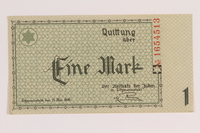
Łódź (Litzmannstadt) ghetto scrip, 1 mark note
Object
1 mark note receipt created in the Łódź ghetto and recovered from the ghetto by Malwina (Inka) Gerson and her parents, Dora and Gustav. When the Germans transferred Jews to the ghetto, they confiscated all currency in exchange for Quittungen [receipts] that could be spent only inside the ghetto. The scrip was designed by the Judenrat [Jewish Council] and includes traditional Jewish symbols. After the German occupation of Poland in 1939, 11 year old Inka and her family were forced into the Jewish ghetto in Łódź, which was renamed Litzmannstadt by the Germans. All ghetto inhabitants over the age of 10 had to work and Inka worked in a hat-making workshop. The Germans destroyed the ghetto in July 1944 and Inka's family was part of the work detail kept to clean up and salvage materials from the ghetto and to dig mass graves. The Allen family avoided the subsequent deportations to concentration camps and were still living in the ghetto when the city was liberated by the Russian Army in early 1945. The family left Poland for Bolivia in 1945.
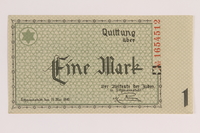
Łódź (Litzmannstadt) ghetto scrip, 1 mark note
Object
1 mark note receipt created in the Łódź ghetto and recovered from the ghetto by Malwina (Inka) Gerson and her parents, Dora and Gustav. When the Germans transferred Jews to the ghetto, they confiscated all currency in exchange for Quittungen [receipts] that could be spent only inside the ghetto. The scrip was designed by the Judenrat [Jewish Council] and includes traditional Jewish symbols. After the German occupation of Poland in 1939, 11 year old Inka and her family were forced into the Jewish ghetto in Łódź, which was renamed Litzmannstadt by the Germans. All ghetto inhabitants over the age of 10 had to work and Inka worked in a hat-making workshop. The Germans destroyed the ghetto in July 1944 and Inka's family was part of the work detail kept to clean up and salvage materials from the ghetto and to dig mass graves. The Allen family avoided the subsequent deportations to concentration camps and were still living in the ghetto when the city was liberated by the Russian Army in early 1945. The family left Poland for Bolivia in 1945.

Łódź (Litzmannstadt) ghetto scrip, 1 mark note
Object
1 mark note receipt created in the Łódź ghetto and recovered from the ghetto by Malwina (Inka) Gerson and her parents, Dora and Gustav. When the Germans transferred Jews to the ghetto, they confiscated all currency in exchange for Quittungen [receipts] that could be spent only inside the ghetto. The scrip was designed by the Judenrat [Jewish Council] and includes traditional Jewish symbols. After the German occupation of Poland in 1939, 11 year old Inka and her family were forced into the Jewish ghetto in Łódź, which was renamed Litzmannstadt by the Germans. All ghetto inhabitants over the age of 10 had to work and Inka worked in a hat-making workshop. The Germans destroyed the ghetto in July 1944 and Inka's family was part of the work detail kept to clean up and salvage materials from the ghetto and to dig mass graves. The Allen family avoided the subsequent deportations to concentration camps and were still living in the ghetto when the city was liberated by the Russian Army in early 1945. The family left Poland for Bolivia in 1945.
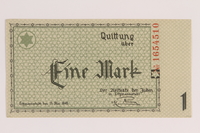
Łódź (Litzmannstadt) ghetto scrip, 1 mark note
Object
1 mark note receipt created in the Łódź ghetto and recovered from the ghetto by Malwina (Inka) Gerson and her parents, Dora and Gustav. When the Germans transferred Jews to the ghetto, they confiscated all currency in exchange for Quittungen [receipts] that could be spent only inside the ghetto. The scrip was designed by the Judenrat [Jewish Council] and includes traditional Jewish symbols. After the German occupation of Poland in 1939, 11 year old Inka and her family were forced into the Jewish ghetto in Łódź, which was renamed Litzmannstadt by the Germans. All ghetto inhabitants over the age of 10 had to work and Inka worked in a hat-making workshop. The Germans destroyed the ghetto in July 1944 and Inka's family was part of the work detail kept to clean up and salvage materials from the ghetto and to dig mass graves. The Allen family avoided the subsequent deportations to concentration camps and were still living in the ghetto when the city was liberated by the Russian Army in early 1945. The family left Poland for Bolivia in 1945.

Łódź (Litzmannstadt) ghetto scrip, 1 mark note
Object
1 mark note receipt created in the Łódź ghetto and recovered from the ghetto by Malwina (Inka) Gerson and her parents, Dora and Gustav. When the Germans transferred Jews to the ghetto, they confiscated all currency in exchange for Quittungen [receipts] that could be spent only inside the ghetto. The scrip was designed by the Judenrat [Jewish Council] and includes traditional Jewish symbols. After the German occupation of Poland in 1939, 11 year old Inka and her family were forced into the Jewish ghetto in Łódź, which was renamed Litzmannstadt by the Germans. All ghetto inhabitants over the age of 10 had to work and Inka worked in a hat-making workshop. The Germans destroyed the ghetto in July 1944 and Inka's family was part of the work detail kept to clean up and salvage materials from the ghetto and to dig mass graves. The Allen family avoided the subsequent deportations to concentration camps and were still living in the ghetto when the city was liberated by the Russian Army in early 1945. The family left Poland for Bolivia in 1945.

Łódź (Litzmannstadt) ghetto scrip, 1 mark note
Object
1 mark note receipt created in the Łódź ghetto and recovered from the ghetto by Malwina (Inka) Gerson and her parents, Dora and Gustav. When the Germans transferred Jews to the ghetto, they confiscated all currency in exchange for Quittungen [receipts] that could be spent only inside the ghetto. The scrip was designed by the Judenrat [Jewish Council] and includes traditional Jewish symbols. After the German occupation of Poland in 1939, 11 year old Inka and her family were forced into the Jewish ghetto in Łódź, which was renamed Litzmannstadt by the Germans. All ghetto inhabitants over the age of 10 had to work and Inka worked in a hat-making workshop. The Germans destroyed the ghetto in July 1944 and Inka's family was part of the work detail kept to clean up and salvage materials from the ghetto and to dig mass graves. The Allen family avoided the subsequent deportations to concentration camps and were still living in the ghetto when the city was liberated by the Russian Army in early 1945. The family left Poland for Bolivia in 1945.
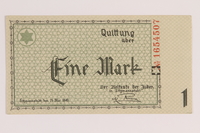
Łódź (Litzmannstadt) ghetto scrip, 1 mark note
Object
1 mark note receipt created in the Łódź ghetto and recovered from the ghetto by Malwina (Inka) Gerson and her parents, Dora and Gustav. When the Germans transferred Jews to the ghetto, they confiscated all currency in exchange for Quittungen [receipts] that could be spent only inside the ghetto. The scrip was designed by the Judenrat [Jewish Council] and includes traditional Jewish symbols. After the German occupation of Poland in 1939, 11 year old Inka and her family were forced into the Jewish ghetto in Łódź, which was renamed Litzmannstadt by the Germans. All ghetto inhabitants over the age of 10 had to work and Inka worked in a hat-making workshop. The Germans destroyed the ghetto in July 1944 and Inka's family was part of the work detail kept to clean up and salvage materials from the ghetto and to dig mass graves. The Allen family avoided the subsequent deportations to concentration camps and were still living in the ghetto when the city was liberated by the Russian Army in early 1945. The family left Poland for Bolivia in 1945.

Łódź (Litzmannstadt) ghetto scrip, 1 mark note
Object
1 mark note receipt created in the Łódź ghetto and recovered from the ghetto by Malwina (Inka) Gerson and her parents, Dora and Gustav. When the Germans transferred Jews to the ghetto, they confiscated all currency in exchange for Quittungen [receipts] that could be spent only inside the ghetto. The scrip was designed by the Judenrat [Jewish Council] and includes traditional Jewish symbols. After the German occupation of Poland in 1939, 11 year old Inka and her family were forced into the Jewish ghetto in Łódź, which was renamed Litzmannstadt by the Germans. All ghetto inhabitants over the age of 10 had to work and Inka worked in a hat-making workshop. The Germans destroyed the ghetto in July 1944 and Inka's family was part of the work detail kept to clean up and salvage materials from the ghetto and to dig mass graves. The Allen family avoided the subsequent deportations to concentration camps and were still living in the ghetto when the city was liberated by the Russian Army in early 1945. The family left Poland for Bolivia in 1945.

Łódź (Litzmannstadt) ghetto scrip, 1 mark note
Object
1 mark note receipt created in the Łódź ghetto and recovered from the ghetto by Malwina (Inka) Gerson and her parents, Dora and Gustav. When the Germans transferred Jews to the ghetto, they confiscated all currency in exchange for Quittungen [receipts] that could be spent only inside the ghetto. The scrip was designed by the Judenrat [Jewish Council] and includes traditional Jewish symbols. After the German occupation of Poland in 1939, 11 year old Inka and her family were forced into the Jewish ghetto in Łódź, which was renamed Litzmannstadt by the Germans. All ghetto inhabitants over the age of 10 had to work and Inka worked in a hat-making workshop. The Germans destroyed the ghetto in July 1944 and Inka's family was part of the work detail kept to clean up and salvage materials from the ghetto and to dig mass graves. The Allen family avoided the subsequent deportations to concentration camps and were still living in the ghetto when the city was liberated by the Russian Army in early 1945. The family left Poland for Bolivia in 1945.

Łódź (Litzmannstadt) ghetto scrip, 1 mark note
Object
1 mark note receipt created in the Łódź ghetto and recovered from the ghetto by Malwina (Inka) Gerson and her parents, Dora and Gustav. When the Germans transferred Jews to the ghetto, they confiscated all currency in exchange for Quittungen [receipts] that could be spent only inside the ghetto. The scrip was designed by the Judenrat [Jewish Council] and includes traditional Jewish symbols. After the German occupation of Poland in 1939, 11 year old Inka and her family were forced into the Jewish ghetto in Łódź, which was renamed Litzmannstadt by the Germans. All ghetto inhabitants over the age of 10 had to work and Inka worked in a hat-making workshop. The Germans destroyed the ghetto in July 1944 and Inka's family was part of the work detail kept to clean up and salvage materials from the ghetto and to dig mass graves. The Allen family avoided the subsequent deportations to concentration camps and were still living in the ghetto when the city was liberated by the Russian Army in early 1945. The family left Poland for Bolivia in 1945.
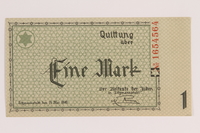
Łódź (Litzmannstadt) ghetto scrip, 1 mark note
Object
1 mark note receipt created in the Łódź ghetto and recovered from the ghetto by Malwina (Inka) Gerson and her parents, Dora and Gustav. When the Germans transferred Jews to the ghetto, they confiscated all currency in exchange for Quittungen [receipts] that could be spent only inside the ghetto. The scrip was designed by the Judenrat [Jewish Council] and includes traditional Jewish symbols. After the German occupation of Poland in 1939, 11 year old Inka and her family were forced into the Jewish ghetto in Łódź, which was renamed Litzmannstadt by the Germans. All ghetto inhabitants over the age of 10 had to work and Inka worked in a hat-making workshop. The Germans destroyed the ghetto in July 1944 and Inka's family was part of the work detail kept to clean up and salvage materials from the ghetto and to dig mass graves. The Allen family avoided the subsequent deportations to concentration camps and were still living in the ghetto when the city was liberated by the Russian Army in early 1945. The family left Poland for Bolivia in 1945.

Łódź (Litzmannstadt) ghetto scrip, 1 mark note
Object
1 mark note receipt created in the Łódź ghetto and recovered from the ghetto by Malwina (Inka) Gerson and her parents, Dora and Gustav. When the Germans transferred Jews to the ghetto, they confiscated all currency in exchange for Quittungen [receipts] that could be spent only inside the ghetto. The scrip was designed by the Judenrat [Jewish Council] and includes traditional Jewish symbols. After the German occupation of Poland in 1939, 11 year old Inka and her family were forced into the Jewish ghetto in Łódź, which was renamed Litzmannstadt by the Germans. All ghetto inhabitants over the age of 10 had to work and Inka worked in a hat-making workshop. The Germans destroyed the ghetto in July 1944 and Inka's family was part of the work detail kept to clean up and salvage materials from the ghetto and to dig mass graves. The Allen family avoided the subsequent deportations to concentration camps and were still living in the ghetto when the city was liberated by the Russian Army in early 1945. The family left Poland for Bolivia in 1945.
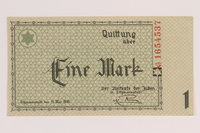
Łódź (Litzmannstadt) ghetto scrip, 1 mark note
Object
1 mark note receipt created in the Łódź ghetto and recovered from the ghetto by Malwina (Inka) Gerson and her parents, Dora and Gustav. When the Germans transferred Jews to the ghetto, they confiscated all currency in exchange for Quittungen [receipts] that could be spent only inside the ghetto. The scrip was designed by the Judenrat [Jewish Council] and includes traditional Jewish symbols. After the German occupation of Poland in 1939, 11 year old Inka and her family were forced into the Jewish ghetto in Łódź, which was renamed Litzmannstadt by the Germans. All ghetto inhabitants over the age of 10 had to work and Inka worked in a hat-making workshop. The Germans destroyed the ghetto in July 1944 and Inka's family was part of the work detail kept to clean up and salvage materials from the ghetto and to dig mass graves. The Allen family avoided the subsequent deportations to concentration camps and were still living in the ghetto when the city was liberated by the Russian Army in early 1945. The family left Poland for Bolivia in 1945.
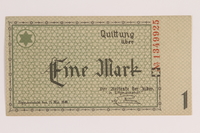
Łódź (Litzmannstadt) ghetto scrip, 1 mark note
Object
1 mark note receipt created in the Łódź ghetto and recovered from the ghetto by Malwina (Inka) Gerson and her parents, Dora and Gustav. When the Germans transferred Jews to the ghetto, they confiscated all currency in exchange for Quittungen [receipts] that could be spent only inside the ghetto. The scrip was designed by the Judenrat [Jewish Council] and includes traditional Jewish symbols. After the German occupation of Poland in 1939, 11 year old Inka and her family were forced into the Jewish ghetto in Łódź, which was renamed Litzmannstadt by the Germans. All ghetto inhabitants over the age of 10 had to work and Inka worked in a hat-making workshop. The Germans destroyed the ghetto in July 1944 and Inka's family was part of the work detail kept to clean up and salvage materials from the ghetto and to dig mass graves. The Allen family avoided the subsequent deportations to concentration camps and were still living in the ghetto when the city was liberated by the Russian Army in early 1945. The family left Poland for Bolivia in 1945.
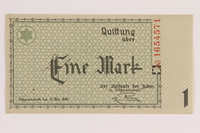
Łódź (Litzmannstadt) ghetto scrip, 1 mark note
Object
1 mark note receipt created in the Łódź ghetto and recovered from the ghetto by Malwina (Inka) Gerson and her parents, Dora and Gustav. When the Germans transferred Jews to the ghetto, they confiscated all currency in exchange for Quittungen [receipts] that could be spent only inside the ghetto. The scrip was designed by the Judenrat [Jewish Council] and includes traditional Jewish symbols. After the German occupation of Poland in 1939, 11 year old Inka and her family were forced into the Jewish ghetto in Łódź, which was renamed Litzmannstadt by the Germans. All ghetto inhabitants over the age of 10 had to work and Inka worked in a hat-making workshop. The Germans destroyed the ghetto in July 1944 and Inka's family was part of the work detail kept to clean up and salvage materials from the ghetto and to dig mass graves. The Allen family avoided the subsequent deportations to concentration camps and were still living in the ghetto when the city was liberated by the Russian Army in early 1945. The family left Poland for Bolivia in 1945.
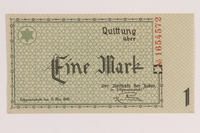
Łódź (Litzmannstadt) ghetto scrip, 1 mark note
Object
1 mark note receipt created in the Łódź ghetto and recovered from the ghetto by Malwina (Inka) Gerson and her parents, Dora and Gustav. When the Germans transferred Jews to the ghetto, they confiscated all currency in exchange for Quittungen [receipts] that could be spent only inside the ghetto. The scrip was designed by the Judenrat [Jewish Council] and includes traditional Jewish symbols. After the German occupation of Poland in 1939, 11 year old Inka and her family were forced into the Jewish ghetto in Łódź, which was renamed Litzmannstadt by the Germans. All ghetto inhabitants over the age of 10 had to work and Inka worked in a hat-making workshop. The Germans destroyed the ghetto in July 1944 and Inka's family was part of the work detail kept to clean up and salvage materials from the ghetto and to dig mass graves. The Allen family avoided the subsequent deportations to concentration camps and were still living in the ghetto when the city was liberated by the Russian Army in early 1945. The family left Poland for Bolivia in 1945.

Łódź (Litzmannstadt) ghetto scrip, 1 mark note
Object
1 mark note receipt created in the Łódź ghetto and recovered from the ghetto by Malwina (Inka) Gerson and her parents, Dora and Gustav. When the Germans transferred Jews to the ghetto, they confiscated all currency in exchange for Quittungen [receipts] that could be spent only inside the ghetto. The scrip was designed by the Judenrat [Jewish Council] and includes traditional Jewish symbols. After the German occupation of Poland in 1939, 11 year old Inka and her family were forced into the Jewish ghetto in Łódź, which was renamed Litzmannstadt by the Germans. All ghetto inhabitants over the age of 10 had to work and Inka worked in a hat-making workshop. The Germans destroyed the ghetto in July 1944 and Inka's family was part of the work detail kept to clean up and salvage materials from the ghetto and to dig mass graves. The Allen family avoided the subsequent deportations to concentration camps and were still living in the ghetto when the city was liberated by the Russian Army in early 1945. The family left Poland for Bolivia in 1945.

Łódź (Litzmannstadt) ghetto scrip, 1 mark note
Object
1 mark note receipt created in the Łódź ghetto and recovered from the ghetto by Malwina (Inka) Gerson and her parents, Dora and Gustav. When the Germans transferred Jews to the ghetto, they confiscated all currency in exchange for Quittungen [receipts] that could be spent only inside the ghetto. The scrip was designed by the Judenrat [Jewish Council] and includes traditional Jewish symbols. After the German occupation of Poland in 1939, 11 year old Inka and her family were forced into the Jewish ghetto in Łódź, which was renamed Litzmannstadt by the Germans. All ghetto inhabitants over the age of 10 had to work and Inka worked in a hat-making workshop. The Germans destroyed the ghetto in July 1944 and Inka's family was part of the work detail kept to clean up and salvage materials from the ghetto and to dig mass graves. The Allen family avoided the subsequent deportations to concentration camps and were still living in the ghetto when the city was liberated by the Russian Army in early 1945. The family left Poland for Bolivia in 1945.

Łódź (Litzmannstadt) ghetto scrip, 1 mark note
Object
1 mark note receipt created in the Łódź ghetto and recovered from the ghetto by Malwina (Inka) Gerson and her parents, Dora and Gustav. When the Germans transferred Jews to the ghetto, they confiscated all currency in exchange for Quittungen [receipts] that could be spent only inside the ghetto. The scrip was designed by the Judenrat [Jewish Council] and includes traditional Jewish symbols. After the German occupation of Poland in 1939, 11 year old Inka and her family were forced into the Jewish ghetto in Łódź, which was renamed Litzmannstadt by the Germans. All ghetto inhabitants over the age of 10 had to work and Inka worked in a hat-making workshop. The Germans destroyed the ghetto in July 1944 and Inka's family was part of the work detail kept to clean up and salvage materials from the ghetto and to dig mass graves. The Allen family avoided the subsequent deportations to concentration camps and were still living in the ghetto when the city was liberated by the Russian Army in early 1945. The family left Poland for Bolivia in 1945.
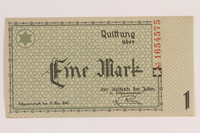
Łódź (Litzmannstadt) ghetto scrip, 1 mark note
Object
1 mark note receipt created in the Łódź ghetto and recovered from the ghetto by Malwina (Inka) Gerson and her parents, Dora and Gustav. When the Germans transferred Jews to the ghetto, they confiscated all currency in exchange for Quittungen [receipts] that could be spent only inside the ghetto. The scrip was designed by the Judenrat [Jewish Council] and includes traditional Jewish symbols. After the German occupation of Poland in 1939, 11 year old Inka and her family were forced into the Jewish ghetto in Łódź, which was renamed Litzmannstadt by the Germans. All ghetto inhabitants over the age of 10 had to work and Inka worked in a hat-making workshop. The Germans destroyed the ghetto in July 1944 and Inka's family was part of the work detail kept to clean up and salvage materials from the ghetto and to dig mass graves. The Allen family avoided the subsequent deportations to concentration camps and were still living in the ghetto when the city was liberated by the Russian Army in early 1945. The family left Poland for Bolivia in 1945.
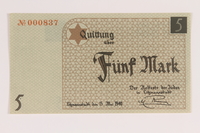
Łódź (Litzmannstadt) ghetto scrip, 5 mark note
Object
5 mark note receipt created in the Łódź ghetto and recovered from the ghetto by Malwina (Inka) Gerson and her parents, Dora and Gustav. When the Germans transferred Jews to the ghetto, they confiscated all currency in exchange for Quittungen [receipts] that could be spent only inside the ghetto. The scrip was designed by the Judenrat [Jewish Council] and includes traditional Jewish symbols. After the German occupation of Poland in 1939, 11 year old Inka and her family were forced into the Jewish ghetto in Łódź, which was renamed Litzmannstadt by the Germans. All ghetto inhabitants over the age of 10 had to work and Inka worked in a hat-making workshop. The Germans destroyed the ghetto in July 1944 and Inka's family was part of the work detail kept to clean up and salvage materials from the ghetto and to dig mass graves. The Allen family avoided the subsequent deportations to concentration camps and were still living in the ghetto when the city was liberated by the Russian Army in early 1945. The family left Poland for Bolivia in 1945.

Łódź (Litzmannstadt) ghetto scrip, 5 mark note
Object
5 mark note receipt created in the Łódź ghetto and recovered from the ghetto by Malwina (Inka) Gerson and her parents, Dora and Gustav. When the Germans transferred Jews to the ghetto, they confiscated all currency in exchange for Quittungen [receipts] that could be spent only inside the ghetto. The scrip was designed by the Judenrat [Jewish Council] and includes traditional Jewish symbols. After the German occupation of Poland in 1939, 11 year old Inka and her family were forced into the Jewish ghetto in Łódź, which was renamed Litzmannstadt by the Germans. All ghetto inhabitants over the age of 10 had to work and Inka worked in a hat-making workshop. The Germans destroyed the ghetto in July 1944 and Inka's family was part of the work detail kept to clean up and salvage materials from the ghetto and to dig mass graves. The Allen family avoided the subsequent deportations to concentration camps and were still living in the ghetto when the city was liberated by the Russian Army in early 1945. The family left Poland for Bolivia in 1945.

Łódź (Litzmannstadt) ghetto scrip, 5 mark note
Object
5 mark note receipt created in the Łódź ghetto and recovered from the ghetto by Malwina (Inka) Gerson and her parents, Dora and Gustav. When the Germans transferred Jews to the ghetto, they confiscated all currency in exchange for Quittungen [receipts] that could be spent only inside the ghetto. The scrip was designed by the Judenrat [Jewish Council] and includes traditional Jewish symbols. After the German occupation of Poland in 1939, 11 year old Inka and her family were forced into the Jewish ghetto in Łódź, which was renamed Litzmannstadt by the Germans. All ghetto inhabitants over the age of 10 had to work and Inka worked in a hat-making workshop. The Germans destroyed the ghetto in July 1944 and Inka's family was part of the work detail kept to clean up and salvage materials from the ghetto and to dig mass graves. The Allen family avoided the subsequent deportations to concentration camps and were still living in the ghetto when the city was liberated by the Russian Army in early 1945. The family left Poland for Bolivia in 1945.

Łódź (Litzmannstadt) ghetto scrip, 5 mark note
Object
5 mark note receipt created in the Łódź ghetto and recovered from the ghetto by Malwina (Inka) Gerson and her parents, Dora and Gustav. When the Germans transferred Jews to the ghetto, they confiscated all currency in exchange for Quittungen [receipts] that could be spent only inside the ghetto. The scrip was designed by the Judenrat [Jewish Council] and includes traditional Jewish symbols. After the German occupation of Poland in 1939, 11 year old Inka and her family were forced into the Jewish ghetto in Łódź, which was renamed Litzmannstadt by the Germans. All ghetto inhabitants over the age of 10 had to work and Inka worked in a hat-making workshop. The Germans destroyed the ghetto in July 1944 and Inka's family was part of the work detail kept to clean up and salvage materials from the ghetto and to dig mass graves. The Allen family avoided the subsequent deportations to concentration camps and were still living in the ghetto when the city was liberated by the Russian Army in early 1945. The family left Poland for Bolivia in 1945.

Łódź (Litzmannstadt) ghetto scrip, 5 mark note
Object
5 mark note receipt created in the Łódź ghetto and recovered from the ghetto by Malwina (Inka) Gerson and her parents, Dora and Gustav. When the Germans transferred Jews to the ghetto, they confiscated all currency in exchange for Quittungen [receipts] that could be spent only inside the ghetto. The scrip was designed by the Judenrat [Jewish Council] and includes traditional Jewish symbols. After the German occupation of Poland in 1939, 11 year old Inka and her family were forced into the Jewish ghetto in Łódź, which was renamed Litzmannstadt by the Germans. All ghetto inhabitants over the age of 10 had to work and Inka worked in a hat-making workshop. The Germans destroyed the ghetto in July 1944 and Inka's family was part of the work detail kept to clean up and salvage materials from the ghetto and to dig mass graves. The Allen family avoided the subsequent deportations to concentration camps and were still living in the ghetto when the city was liberated by the Russian Army in early 1945. The family left Poland for Bolivia in 1945.

Łódź (Litzmannstadt) ghetto scrip, 5 mark note
Object
5 mark note receipt created in the Łódź ghetto and recovered from the ghetto by Malwina (Inka) Gerson and her parents, Dora and Gustav. When the Germans transferred Jews to the ghetto, they confiscated all currency in exchange for Quittungen [receipts] that could be spent only inside the ghetto. The scrip was designed by the Judenrat [Jewish Council] and includes traditional Jewish symbols. After the German occupation of Poland in 1939, 11 year old Inka and her family were forced into the Jewish ghetto in Łódź, which was renamed Litzmannstadt by the Germans. All ghetto inhabitants over the age of 10 had to work and Inka worked in a hat-making workshop. The Germans destroyed the ghetto in July 1944 and Inka's family was part of the work detail kept to clean up and salvage materials from the ghetto and to dig mass graves. The Allen family avoided the subsequent deportations to concentration camps and were still living in the ghetto when the city was liberated by the Russian Army in early 1945. The family left Poland for Bolivia in 1945.
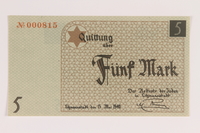
Łódź (Litzmannstadt) ghetto scrip, 5 mark note
Object
5 mark note receipt created in the Łódź ghetto and recovered from the ghetto by Malwina (Inka) Gerson and her parents, Dora and Gustav. When the Germans transferred Jews to the ghetto, they confiscated all currency in exchange for Quittungen [receipts] that could be spent only inside the ghetto. The scrip was designed by the Judenrat [Jewish Council] and includes traditional Jewish symbols. After the German occupation of Poland in 1939, 11 year old Inka and her family were forced into the Jewish ghetto in Łódź, which was renamed Litzmannstadt by the Germans. All ghetto inhabitants over the age of 10 had to work and Inka worked in a hat-making workshop. The Germans destroyed the ghetto in July 1944 and Inka's family was part of the work detail kept to clean up and salvage materials from the ghetto and to dig mass graves. The Allen family avoided the subsequent deportations to concentration camps and were still living in the ghetto when the city was liberated by the Russian Army in early 1945. The family left Poland for Bolivia in 1945.
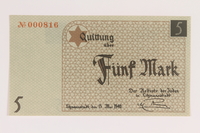
Łódź (Litzmannstadt) ghetto scrip, 5 mark note
Object
5 mark note receipt created in the Łódź ghetto and recovered from the ghetto by Malwina (Inka) Gerson and her parents, Dora and Gustav. When the Germans transferred Jews to the ghetto, they confiscated all currency in exchange for Quittungen [receipts] that could be spent only inside the ghetto. The scrip was designed by the Judenrat [Jewish Council] and includes traditional Jewish symbols. After the German occupation of Poland in 1939, 11 year old Inka and her family were forced into the Jewish ghetto in Łódź, which was renamed Litzmannstadt by the Germans. All ghetto inhabitants over the age of 10 had to work and Inka worked in a hat-making workshop. The Germans destroyed the ghetto in July 1944 and Inka's family was part of the work detail kept to clean up and salvage materials from the ghetto and to dig mass graves. The Allen family avoided the subsequent deportations to concentration camps and were still living in the ghetto when the city was liberated by the Russian Army in early 1945. The family left Poland for Bolivia in 1945.

Łódź (Litzmannstadt) ghetto scrip, 5 mark note
Object
5 mark note receipt created in the Łódź ghetto and recovered from the ghetto by Malwina (Inka) Gerson and her parents, Dora and Gustav. When the Germans transferred Jews to the ghetto, they confiscated all currency in exchange for Quittungen [receipts] that could be spent only inside the ghetto. The scrip was designed by the Judenrat [Jewish Council] and includes traditional Jewish symbols. After the German occupation of Poland in 1939, 11 year old Inka and her family were forced into the Jewish ghetto in Łódź, which was renamed Litzmannstadt by the Germans. All ghetto inhabitants over the age of 10 had to work and Inka worked in a hat-making workshop. The Germans destroyed the ghetto in July 1944 and Inka's family was part of the work detail kept to clean up and salvage materials from the ghetto and to dig mass graves. The Allen family avoided the subsequent deportations to concentration camps and were still living in the ghetto when the city was liberated by the Russian Army in early 1945. The family left Poland for Bolivia in 1945.
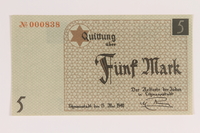
Łódź (Litzmannstadt) ghetto scrip, 5 mark note
Object
5 mark note receipt created in the Łódź ghetto and recovered from the ghetto by Malwina (Inka) Gerson and her parents, Dora and Gustav. When the Germans transferred Jews to the ghetto, they confiscated all currency in exchange for Quittungen [receipts] that could be spent only inside the ghetto. The scrip was designed by the Judenrat [Jewish Council] and includes traditional Jewish symbols. After the German occupation of Poland in 1939, 11 year old Inka and her family were forced into the Jewish ghetto in Łódź, which was renamed Litzmannstadt by the Germans. All ghetto inhabitants over the age of 10 had to work and Inka worked in a hat-making workshop. The Germans destroyed the ghetto in July 1944 and Inka's family was part of the work detail kept to clean up and salvage materials from the ghetto and to dig mass graves. The Allen family avoided the subsequent deportations to concentration camps and were still living in the ghetto when the city was liberated by the Russian Army in early 1945. The family left Poland for Bolivia in 1945.
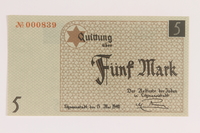
Łódź (Litzmannstadt) ghetto scrip, 5 mark note
Object
5 mark note receipt created in the Łódź ghetto and recovered from the ghetto by Malwina (Inka) Gerson and her parents, Dora and Gustav. When the Germans transferred Jews to the ghetto, they confiscated all currency in exchange for Quittungen [receipts] that could be spent only inside the ghetto. The scrip was designed by the Judenrat [Jewish Council] and includes traditional Jewish symbols. After the German occupation of Poland in 1939, 11 year old Inka and her family were forced into the Jewish ghetto in Łódź, which was renamed Litzmannstadt by the Germans. All ghetto inhabitants over the age of 10 had to work and Inka worked in a hat-making workshop. The Germans destroyed the ghetto in July 1944 and Inka's family was part of the work detail kept to clean up and salvage materials from the ghetto and to dig mass graves. The Allen family avoided the subsequent deportations to concentration camps and were still living in the ghetto when the city was liberated by the Russian Army in early 1945. The family left Poland for Bolivia in 1945.
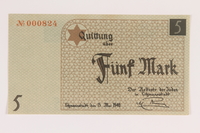
Łódź (Litzmannstadt) ghetto scrip, 5 mark note
Object
5 mark note receipt created in the Łódź ghetto and recovered from the ghetto by Malwina (Inka) Gerson and her parents, Dora and Gustav. When the Germans transferred Jews to the ghetto, they confiscated all currency in exchange for Quittungen [receipts] that could be spent only inside the ghetto. The scrip was designed by the Judenrat [Jewish Council] and includes traditional Jewish symbols. After the German occupation of Poland in 1939, 11 year old Inka and her family were forced into the Jewish ghetto in Łódź, which was renamed Litzmannstadt by the Germans. All ghetto inhabitants over the age of 10 had to work and Inka worked in a hat-making workshop. The Germans destroyed the ghetto in July 1944 and Inka's family was part of the work detail kept to clean up and salvage materials from the ghetto and to dig mass graves. The Allen family avoided the subsequent deportations to concentration camps and were still living in the ghetto when the city was liberated by the Russian Army in early 1945. The family left Poland for Bolivia in 1945.
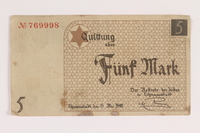
Łódź (Litzmannstadt) ghetto scrip, 5 mark note
Object
5 mark note receipt created in the Łódź ghetto and recovered from the ghetto by Malwina (Inka) Gerson and her parents, Dora and Gustav. When the Germans transferred Jews to the ghetto, they confiscated all currency in exchange for Quittungen [receipts] that could be spent only inside the ghetto. The scrip was designed by the Judenrat [Jewish Council] and includes traditional Jewish symbols. After the German occupation of Poland in 1939, 11 year old Inka and her family were forced into the Jewish ghetto in Łódź, which was renamed Litzmannstadt by the Germans. All ghetto inhabitants over the age of 10 had to work and Inka worked in a hat-making workshop. The Germans destroyed the ghetto in July 1944 and Inka's family was part of the work detail kept to clean up and salvage materials from the ghetto and to dig mass graves. The Allen family avoided the subsequent deportations to concentration camps and were still living in the ghetto when the city was liberated by the Russian Army in early 1945. The family left Poland for Bolivia in 1945.
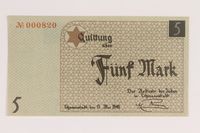
Łódź (Litzmannstadt) ghetto scrip, 5 mark note
Object
5 mark note receipt created in the Łódź ghetto and recovered from the ghetto by Malwina (Inka) Gerson and her parents, Dora and Gustav. When the Germans transferred Jews to the ghetto, they confiscated all currency in exchange for Quittungen [receipts] that could be spent only inside the ghetto. The scrip was designed by the Judenrat [Jewish Council] and includes traditional Jewish symbols. After the German occupation of Poland in 1939, 11 year old Inka and her family were forced into the Jewish ghetto in Łódź, which was renamed Litzmannstadt by the Germans. All ghetto inhabitants over the age of 10 had to work and Inka worked in a hat-making workshop. The Germans destroyed the ghetto in July 1944 and Inka's family was part of the work detail kept to clean up and salvage materials from the ghetto and to dig mass graves. The Allen family avoided the subsequent deportations to concentration camps and were still living in the ghetto when the city was liberated by the Russian Army in early 1945. The family left Poland for Bolivia in 1945.
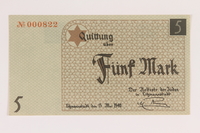
Łódź (Litzmannstadt) ghetto scrip, 5 mark note
Object
5 mark note receipt created in the Łódź ghetto and recovered from the ghetto by Malwina (Inka) Gerson and her parents, Dora and Gustav. When the Germans transferred Jews to the ghetto, they confiscated all currency in exchange for Quittungen [receipts] that could be spent only inside the ghetto. The scrip was designed by the Judenrat [Jewish Council] and includes traditional Jewish symbols. After the German occupation of Poland in 1939, 11 year old Inka and her family were forced into the Jewish ghetto in Łódź, which was renamed Litzmannstadt by the Germans. All ghetto inhabitants over the age of 10 had to work and Inka worked in a hat-making workshop. The Germans destroyed the ghetto in July 1944 and Inka's family was part of the work detail kept to clean up and salvage materials from the ghetto and to dig mass graves. The Allen family avoided the subsequent deportations to concentration camps and were still living in the ghetto when the city was liberated by the Russian Army in early 1945. The family left Poland for Bolivia in 1945.

Łódź (Litzmannstadt) ghetto scrip, 5 mark note
Object
5 mark note receipt created in the Łódź ghetto and recovered from the ghetto by Malwina (Inka) Gerson and her parents, Dora and Gustav. When the Germans transferred Jews to the ghetto, they confiscated all currency in exchange for Quittungen [receipts] that could be spent only inside the ghetto. The scrip was designed by the Judenrat [Jewish Council] and includes traditional Jewish symbols. After the German occupation of Poland in 1939, 11 year old Inka and her family were forced into the Jewish ghetto in Łódź, which was renamed Litzmannstadt by the Germans. All ghetto inhabitants over the age of 10 had to work and Inka worked in a hat-making workshop. The Germans destroyed the ghetto in July 1944 and Inka's family was part of the work detail kept to clean up and salvage materials from the ghetto and to dig mass graves. The Allen family avoided the subsequent deportations to concentration camps and were still living in the ghetto when the city was liberated by the Russian Army in early 1945. The family left Poland for Bolivia in 1945.
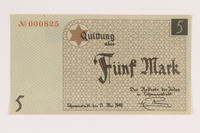
Łódź (Litzmannstadt) ghetto scrip, 5 mark note
Object
5 mark note receipt created in the Łódź ghetto and recovered from the ghetto by Malwina (Inka) Gerson and her parents, Dora and Gustav. When the Germans transferred Jews to the ghetto, they confiscated all currency in exchange for Quittungen [receipts] that could be spent only inside the ghetto. The scrip was designed by the Judenrat [Jewish Council] and includes traditional Jewish symbols. After the German occupation of Poland in 1939, 11 year old Inka and her family were forced into the Jewish ghetto in Łódź, which was renamed Litzmannstadt by the Germans. All ghetto inhabitants over the age of 10 had to work and Inka worked in a hat-making workshop. The Germans destroyed the ghetto in July 1944 and Inka's family was part of the work detail kept to clean up and salvage materials from the ghetto and to dig mass graves. The Allen family avoided the subsequent deportations to concentration camps and were still living in the ghetto when the city was liberated by the Russian Army in early 1945. The family left Poland for Bolivia in 1945.

Łódź (Litzmannstadt) ghetto scrip, 5 mark note
Object
5 mark note receipt created in the Łódź ghetto and recovered from the ghetto by Malwina (Inka) Gerson and her parents, Dora and Gustav. When the Germans transferred Jews to the ghetto, they confiscated all currency in exchange for Quittungen [receipts] that could be spent only inside the ghetto. The scrip was designed by the Judenrat [Jewish Council] and includes traditional Jewish symbols. After the German occupation of Poland in 1939, 11 year old Inka and her family were forced into the Jewish ghetto in Łódź, which was renamed Litzmannstadt by the Germans. All ghetto inhabitants over the age of 10 had to work and Inka worked in a hat-making workshop. The Germans destroyed the ghetto in July 1944 and Inka's family was part of the work detail kept to clean up and salvage materials from the ghetto and to dig mass graves. The Allen family avoided the subsequent deportations to concentration camps and were still living in the ghetto when the city was liberated by the Russian Army in early 1945. The family left Poland for Bolivia in 1945.
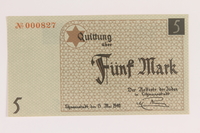
Łódź (Litzmannstadt) ghetto scrip, 5 mark note
Object
5 mark note receipt created in the Łódź ghetto and recovered from the ghetto by Malwina (Inka) Gerson and her parents, Dora and Gustav. When the Germans transferred Jews to the ghetto, they confiscated all currency in exchange for Quittungen [receipts] that could be spent only inside the ghetto. The scrip was designed by the Judenrat [Jewish Council] and includes traditional Jewish symbols. After the German occupation of Poland in 1939, 11 year old Inka and her family were forced into the Jewish ghetto in Łódź, which was renamed Litzmannstadt by the Germans. All ghetto inhabitants over the age of 10 had to work and Inka worked in a hat-making workshop. The Germans destroyed the ghetto in July 1944 and Inka's family was part of the work detail kept to clean up and salvage materials from the ghetto and to dig mass graves. The Allen family avoided the subsequent deportations to concentration camps and were still living in the ghetto when the city was liberated by the Russian Army in early 1945. The family left Poland for Bolivia in 1945.

Łódź (Litzmannstadt) ghetto scrip, 5 mark note
Object
5 mark note receipt created in the Łódź ghetto and recovered from the ghetto by Malwina (Inka) Gerson and her parents, Dora and Gustav. When the Germans transferred Jews to the ghetto, they confiscated all currency in exchange for Quittungen [receipts] that could be spent only inside the ghetto. The scrip was designed by the Judenrat [Jewish Council] and includes traditional Jewish symbols. After the German occupation of Poland in 1939, 11 year old Inka and her family were forced into the Jewish ghetto in Łódź, which was renamed Litzmannstadt by the Germans. All ghetto inhabitants over the age of 10 had to work and Inka worked in a hat-making workshop. The Germans destroyed the ghetto in July 1944 and Inka's family was part of the work detail kept to clean up and salvage materials from the ghetto and to dig mass graves. The Allen family avoided the subsequent deportations to concentration camps and were still living in the ghetto when the city was liberated by the Russian Army in early 1945. The family left Poland for Bolivia in 1945.
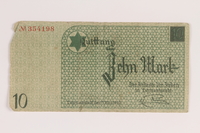
Łódź (Litzmannstadt) ghetto scrip, 10 mark note
Object
10 (zehn) mark note receipt created in the Łódź ghetto and recovered from the ghetto by Malwina (Inka) Gerson and her parents, Dora and Gustav. When the Germans transferred Jews to the ghetto, they confiscated all currency in exchange for Quittungen [receipts] that could be spent only inside the ghetto. The scrip was designed by the Judenrat [Jewish Council] and includes traditional Jewish symbols. After the German occupation of Poland in 1939, 11 year old Inka and her family were forced into the Jewish ghetto in Łódź, which was renamed Litzmannstadt by the Germans. All ghetto inhabitants over the age of 10 had to work and Inka worked in a hat-making workshop. The Germans destroyed the ghetto in July 1944 and Inka's family was part of the work detail kept to clean up and salvage materials from the ghetto and to dig mass graves. The Allen family avoided the subsequent deportations to concentration camps and were still living in the ghetto when the city was liberated by the Russian Army in early 1945. The family left Poland for Bolivia in 1945.
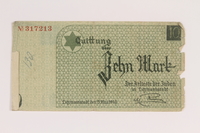
Łódź (Litzmannstadt) ghetto scrip, 10 mark note
Object
10 (zehn) mark note receipt created in the Łódź ghetto and recovered from the ghetto by Malwina (Inka) Gerson and her parents, Dora and Gustav. When the Germans transferred Jews to the ghetto, they confiscated all currency in exchange for Quittungen [receipts] that could be spent only inside the ghetto. The scrip was designed by the Judenrat [Jewish Council] and includes traditional Jewish symbols. After the German occupation of Poland in 1939, 11 year old Inka and her family were forced into the Jewish ghetto in Łódź, which was renamed Litzmannstadt by the Germans. All ghetto inhabitants over the age of 10 had to work and Inka worked in a hat-making workshop. The Germans destroyed the ghetto in July 1944 and Inka's family was part of the work detail kept to clean up and salvage materials from the ghetto and to dig mass graves. The Allen family avoided the subsequent deportations to concentration camps and were still living in the ghetto when the city was liberated by the Russian Army in early 1945. The family left Poland for Bolivia in 1945.
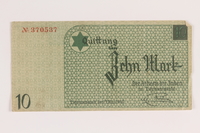
Łódź (Litzmannstadt) ghetto scrip, 10 mark note
Object
10 (zehn) mark note receipt created in the Łódź ghetto and recovered from the ghetto by Malwina (Inka) Gerson and her parents, Dora and Gustav. When the Germans transferred Jews to the ghetto, they confiscated all currency in exchange for Quittungen [receipts] that could be spent only inside the ghetto. The scrip was designed by the Judenrat [Jewish Council] and includes traditional Jewish symbols. After the German occupation of Poland in 1939, 11 year old Inka and her family were forced into the Jewish ghetto in Łódź, which was renamed Litzmannstadt by the Germans. All ghetto inhabitants over the age of 10 had to work and Inka worked in a hat-making workshop. The Germans destroyed the ghetto in July 1944 and Inka's family was part of the work detail kept to clean up and salvage materials from the ghetto and to dig mass graves. The Allen family avoided the subsequent deportations to concentration camps and were still living in the ghetto when the city was liberated by the Russian Army in early 1945. The family left Poland for Bolivia in 1945.
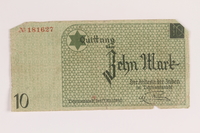
Łódź (Litzmannstadt) ghetto scrip, 10 mark note
Object
10 (zehn) mark note receipt created in the Łódź ghetto and recovered from the ghetto by Malwina (Inka) Gerson and her parents, Dora and Gustav. When the Germans transferred Jews to the ghetto, they confiscated all currency in exchange for Quittungen [receipts] that could be spent only inside the ghetto. The scrip was designed by the Judenrat [Jewish Council] and includes traditional Jewish symbols. After the German occupation of Poland in 1939, 11 year old Inka and her family were forced into the Jewish ghetto in Łódź, which was renamed Litzmannstadt by the Germans. All ghetto inhabitants over the age of 10 had to work and Inka worked in a hat-making workshop. The Germans destroyed the ghetto in July 1944 and Inka's family was part of the work detail kept to clean up and salvage materials from the ghetto and to dig mass graves. The Allen family avoided the subsequent deportations to concentration camps and were still living in the ghetto when the city was liberated by the Russian Army in early 1945. The family left Poland for Bolivia in 1945.

Łódź (Litzmannstadt) ghetto scrip, 10 mark note
Object
10 (zehn) mark note receipt created in the Łódź ghetto and recovered from the ghetto by Malwina (Inka) Gerson and her parents, Dora and Gustav. When the Germans transferred Jews to the ghetto, they confiscated all currency in exchange for Quittungen [receipts] that could be spent only inside the ghetto. The scrip was designed by the Judenrat [Jewish Council] and includes traditional Jewish symbols. After the German occupation of Poland in 1939, 11 year old Inka and her family were forced into the Jewish ghetto in Łódź, which was renamed Litzmannstadt by the Germans. All ghetto inhabitants over the age of 10 had to work and Inka worked in a hat-making workshop. The Germans destroyed the ghetto in July 1944 and Inka's family was part of the work detail kept to clean up and salvage materials from the ghetto and to dig mass graves. The Allen family avoided the subsequent deportations to concentration camps and were still living in the ghetto when the city was liberated by the Russian Army in early 1945. The family left Poland for Bolivia in 1945.

Łódź (Litzmannstadt) ghetto scrip, 10 mark note
Object
10 (zehn) mark note receipt created in the Łódź ghetto and recovered from the ghetto by Malwina (Inka) Gerson and her parents, Dora and Gustav. When the Germans transferred Jews to the ghetto, they confiscated all currency in exchange for Quittungen [receipts] that could be spent only inside the ghetto. The scrip was designed by the Judenrat [Jewish Council] and includes traditional Jewish symbols. After the German occupation of Poland in 1939, 11 year old Inka and her family were forced into the Jewish ghetto in Łódź, which was renamed Litzmannstadt by the Germans. All ghetto inhabitants over the age of 10 had to work and Inka worked in a hat-making workshop. The Germans destroyed the ghetto in July 1944 and Inka's family was part of the work detail kept to clean up and salvage materials from the ghetto and to dig mass graves. The Allen family avoided the subsequent deportations to concentration camps and were still living in the ghetto when the city was liberated by the Russian Army in early 1945. The family left Poland for Bolivia in 1945.
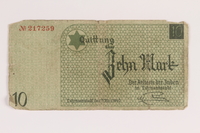
Łódź (Litzmannstadt) ghetto scrip, 10 mark note
Object
10 (zehn) mark note receipt created in the Łódź ghetto and recovered from the ghetto by Malwina (Inka) Gerson and her parents, Dora and Gustav. When the Germans transferred Jews to the ghetto, they confiscated all currency in exchange for Quittungen [receipts] that could be spent only inside the ghetto. The scrip was designed by the Judenrat [Jewish Council] and includes traditional Jewish symbols. After the German occupation of Poland in 1939, 11 year old Inka and her family were forced into the Jewish ghetto in Łódź, which was renamed Litzmannstadt by the Germans. All ghetto inhabitants over the age of 10 had to work and Inka worked in a hat-making workshop. The Germans destroyed the ghetto in July 1944 and Inka's family was part of the work detail kept to clean up and salvage materials from the ghetto and to dig mass graves. The Allen family avoided the subsequent deportations to concentration camps and were still living in the ghetto when the city was liberated by the Russian Army in early 1945. The family left Poland for Bolivia in 1945.
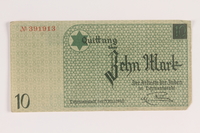
Łódź (Litzmannstadt) ghetto scrip, 10 mark note
Object
10 (zehn) mark note receipt created in the Łódź ghetto and recovered from the ghetto by Malwina (Inka) Gerson and her parents, Dora and Gustav. When the Germans transferred Jews to the ghetto, they confiscated all currency in exchange for Quittungen [receipts] that could be spent only inside the ghetto. The scrip was designed by the Judenrat [Jewish Council] and includes traditional Jewish symbols. After the German occupation of Poland in 1939, 11 year old Inka and her family were forced into the Jewish ghetto in Łódź, which was renamed Litzmannstadt by the Germans. All ghetto inhabitants over the age of 10 had to work and Inka worked in a hat-making workshop. The Germans destroyed the ghetto in July 1944 and Inka's family was part of the work detail kept to clean up and salvage materials from the ghetto and to dig mass graves. The Allen family avoided the subsequent deportations to concentration camps and were still living in the ghetto when the city was liberated by the Russian Army in early 1945. The family left Poland for Bolivia in 1945.

Łódź (Litzmannstadt) ghetto scrip, 10 mark note
Object
10 (zehn) mark note receipt created in the Łódź ghetto and recovered from the ghetto by Malwina (Inka) Gerson and her parents, Dora and Gustav. When the Germans transferred Jews to the ghetto, they confiscated all currency in exchange for Quittungen [receipts] that could be spent only inside the ghetto. The scrip was designed by the Judenrat [Jewish Council] and includes traditional Jewish symbols. After the German occupation of Poland in 1939, 11 year old Inka and her family were forced into the Jewish ghetto in Łódź, which was renamed Litzmannstadt by the Germans. All ghetto inhabitants over the age of 10 had to work and Inka worked in a hat-making workshop. The Germans destroyed the ghetto in July 1944 and Inka's family was part of the work detail kept to clean up and salvage materials from the ghetto and to dig mass graves. The Allen family avoided the subsequent deportations to concentration camps and were still living in the ghetto when the city was liberated by the Russian Army in early 1945. The family left Poland for Bolivia in 1945.

Łódź (Litzmannstadt) ghetto scrip, 10 mark note
Object
10 (zehn) mark note receipt created in the Łódź ghetto and recovered from the ghetto by Malwina (Inka) Gerson and her parents, Dora and Gustav. When the Germans transferred Jews to the ghetto, they confiscated all currency in exchange for Quittungen [receipts] that could be spent only inside the ghetto. The scrip was designed by the Judenrat [Jewish Council] and includes traditional Jewish symbols. After the German occupation of Poland in 1939, 11 year old Inka and her family were forced into the Jewish ghetto in Łódź, which was renamed Litzmannstadt by the Germans. All ghetto inhabitants over the age of 10 had to work and Inka worked in a hat-making workshop. The Germans destroyed the ghetto in July 1944 and Inka's family was part of the work detail kept to clean up and salvage materials from the ghetto and to dig mass graves. The Allen family avoided the subsequent deportations to concentration camps and were still living in the ghetto when the city was liberated by the Russian Army in early 1945. The family left Poland for Bolivia in 1945.

Łódź (Litzmannstadt) ghetto scrip, 10 mark note
Object
10 (zehn) mark note receipt created in the Łódź ghetto and recovered from the ghetto by Malwina (Inka) Gerson and her parents, Dora and Gustav. When the Germans transferred Jews to the ghetto, they confiscated all currency in exchange for Quittungen [receipts] that could be spent only inside the ghetto. The scrip was designed by the Judenrat [Jewish Council] and includes traditional Jewish symbols. After the German occupation of Poland in 1939, 11 year old Inka and her family were forced into the Jewish ghetto in Łódź, which was renamed Litzmannstadt by the Germans. All ghetto inhabitants over the age of 10 had to work and Inka worked in a hat-making workshop. The Germans destroyed the ghetto in July 1944 and Inka's family was part of the work detail kept to clean up and salvage materials from the ghetto and to dig mass graves. The Allen family avoided the subsequent deportations to concentration camps and were still living in the ghetto when the city was liberated by the Russian Army in early 1945. The family left Poland for Bolivia in 1945.
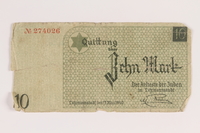
Łódź (Litzmannstadt) ghetto scrip, 10 mark note
Object
10 (zehn) mark note receipt created in the Łódź ghetto and recovered from the ghetto by Malwina (Inka) Gerson and her parents, Dora and Gustav. When the Germans transferred Jews to the ghetto, they confiscated all currency in exchange for Quittungen [receipts] that could be spent only inside the ghetto. The scrip was designed by the Judenrat [Jewish Council] and includes traditional Jewish symbols. After the German occupation of Poland in 1939, 11 year old Inka and her family were forced into the Jewish ghetto in Łódź, which was renamed Litzmannstadt by the Germans. All ghetto inhabitants over the age of 10 had to work and Inka worked in a hat-making workshop. The Germans destroyed the ghetto in July 1944 and Inka's family was part of the work detail kept to clean up and salvage materials from the ghetto and to dig mass graves. The Allen family avoided the subsequent deportations to concentration camps and were still living in the ghetto when the city was liberated by the Russian Army in early 1945. The family left Poland for Bolivia in 1945.

Łódź (Litzmannstadt) ghetto scrip, 10 mark note
Object
10 (zehn) mark note receipt created in the Łódź ghetto and recovered from the ghetto by Malwina (Inka) Gerson and her parents, Dora and Gustav. When the Germans transferred Jews to the ghetto, they confiscated all currency in exchange for Quittungen [receipts] that could be spent only inside the ghetto. The scrip was designed by the Judenrat [Jewish Council] and includes traditional Jewish symbols. After the German occupation of Poland in 1939, 11 year old Inka and her family were forced into the Jewish ghetto in Łódź, which was renamed Litzmannstadt by the Germans. All ghetto inhabitants over the age of 10 had to work and Inka worked in a hat-making workshop. The Germans destroyed the ghetto in July 1944 and Inka's family was part of the work detail kept to clean up and salvage materials from the ghetto and to dig mass graves. The Allen family avoided the subsequent deportations to concentration camps and were still living in the ghetto when the city was liberated by the Russian Army in early 1945. The family left Poland for Bolivia in 1945.
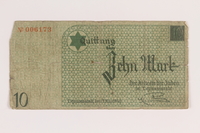
Łódź (Litzmannstadt) ghetto scrip, 10 mark note
Object
10 (zehn) mark note receipt created in the Łódź ghetto and recovered from the ghetto by Malwina (Inka) Gerson and her parents, Dora and Gustav. When the Germans transferred Jews to the ghetto, they confiscated all currency in exchange for Quittungen [receipts] that could be spent only inside the ghetto. The scrip was designed by the Judenrat [Jewish Council] and includes traditional Jewish symbols. After the German occupation of Poland in 1939, 11 year old Inka and her family were forced into the Jewish ghetto in Łódź, which was renamed Litzmannstadt by the Germans. All ghetto inhabitants over the age of 10 had to work and Inka worked in a hat-making workshop. The Germans destroyed the ghetto in July 1944 and Inka's family was part of the work detail kept to clean up and salvage materials from the ghetto and to dig mass graves. The Allen family avoided the subsequent deportations to concentration camps and were still living in the ghetto when the city was liberated by the Russian Army in early 1945. The family left Poland for Bolivia in 1945.
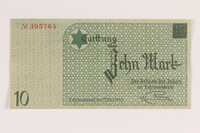
Łódź (Litzmannstadt) ghetto scrip, 10 mark note
Object
10 (zehn) mark note receipt created in the Łódź ghetto and recovered from the ghetto by Malwina (Inka) Gerson and her parents, Dora and Gustav. When the Germans transferred Jews to the ghetto, they confiscated all currency in exchange for Quittungen [receipts] that could be spent only inside the ghetto. The scrip was designed by the Judenrat [Jewish Council] and includes traditional Jewish symbols. After the German occupation of Poland in 1939, 11 year old Inka and her family were forced into the Jewish ghetto in Łódź, which was renamed Litzmannstadt by the Germans. All ghetto inhabitants over the age of 10 had to work and Inka worked in a hat-making workshop. The Germans destroyed the ghetto in July 1944 and Inka's family was part of the work detail kept to clean up and salvage materials from the ghetto and to dig mass graves. The Allen family avoided the subsequent deportations to concentration camps and were still living in the ghetto when the city was liberated by the Russian Army in early 1945. The family left Poland for Bolivia in 1945.

